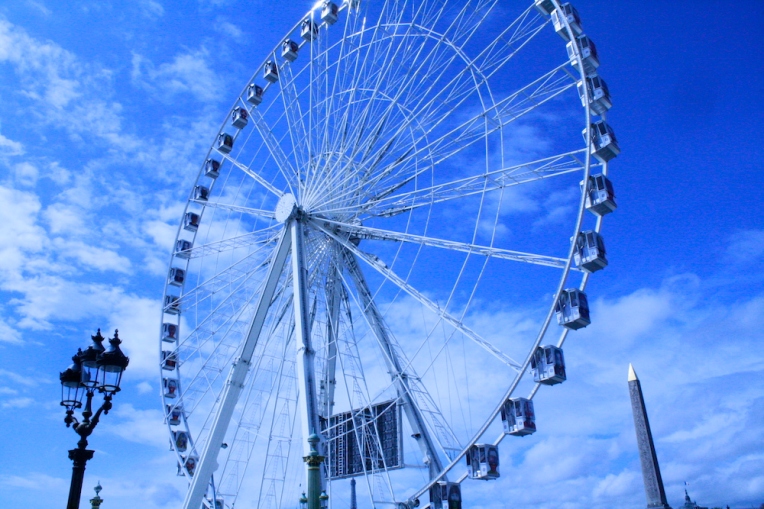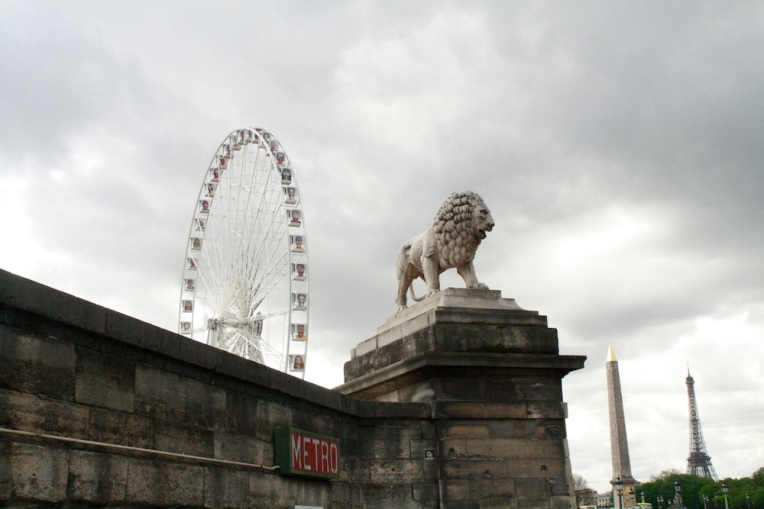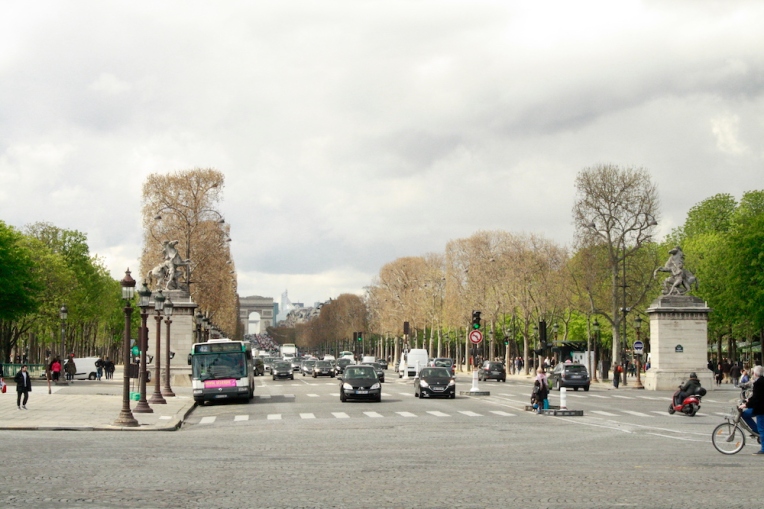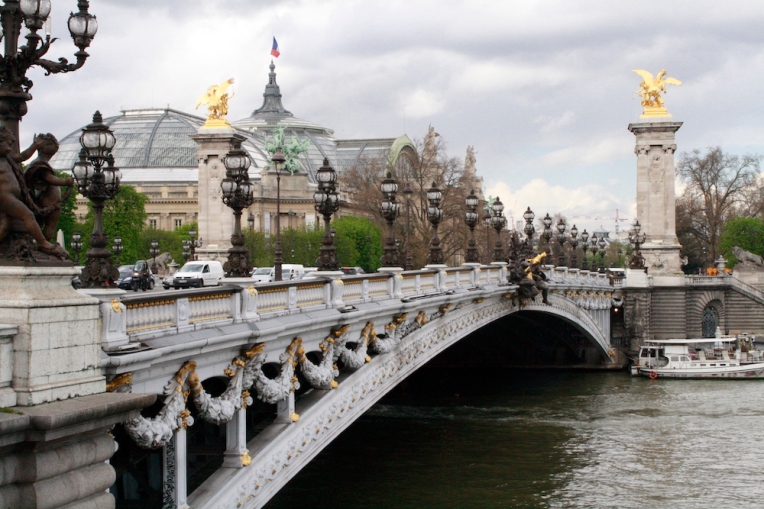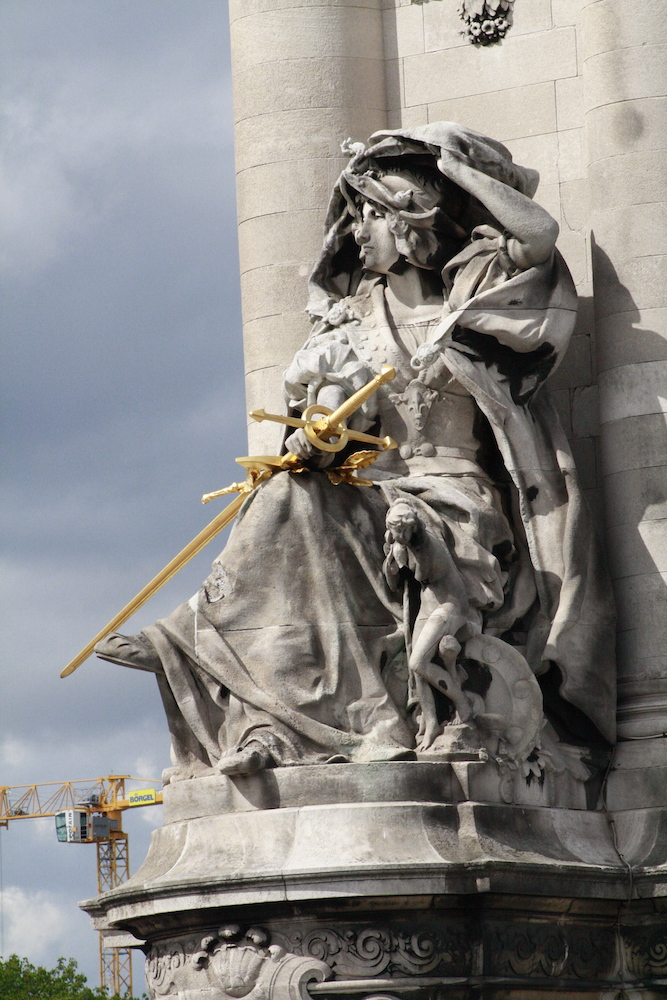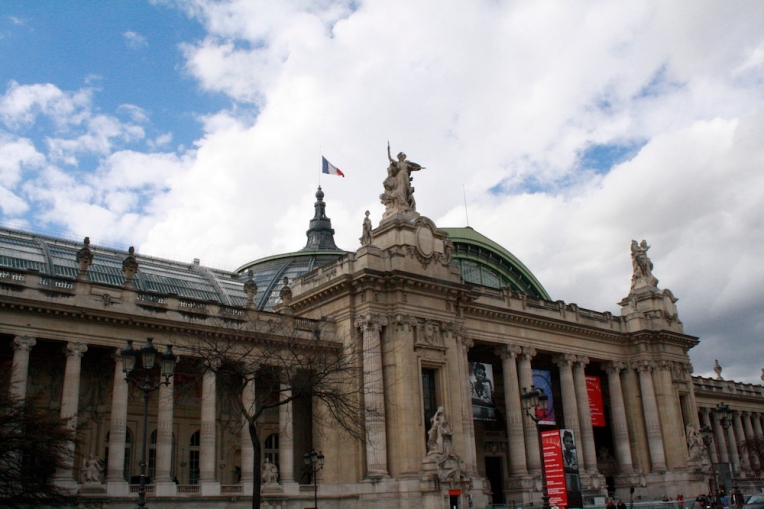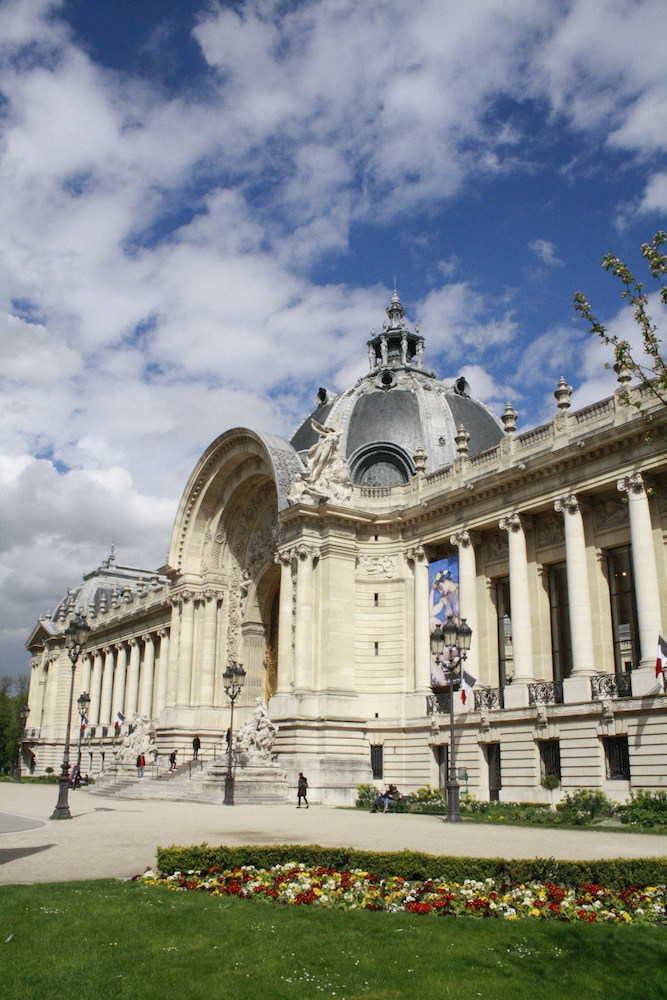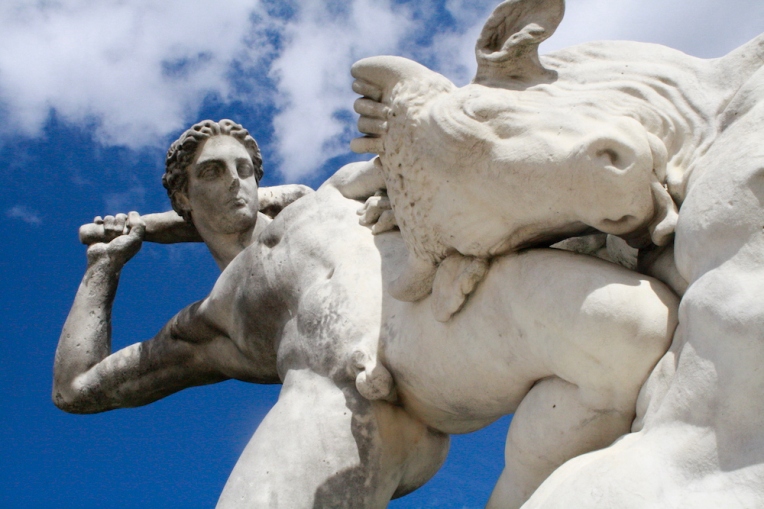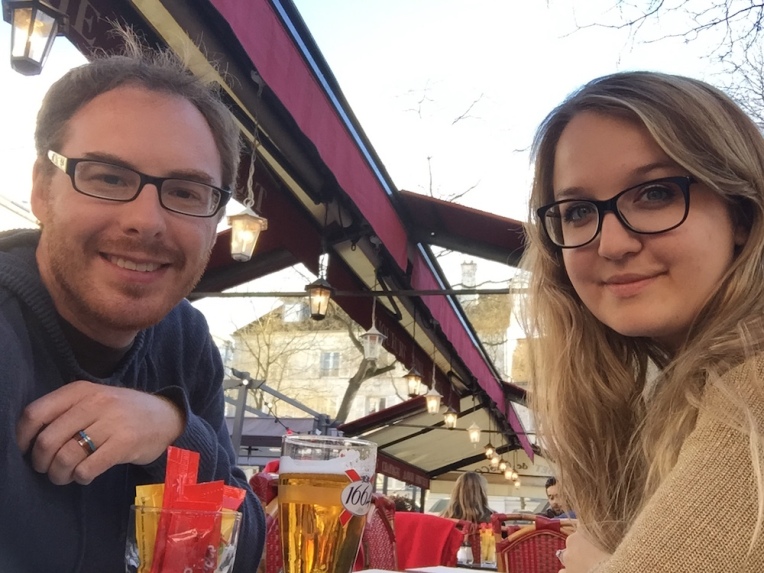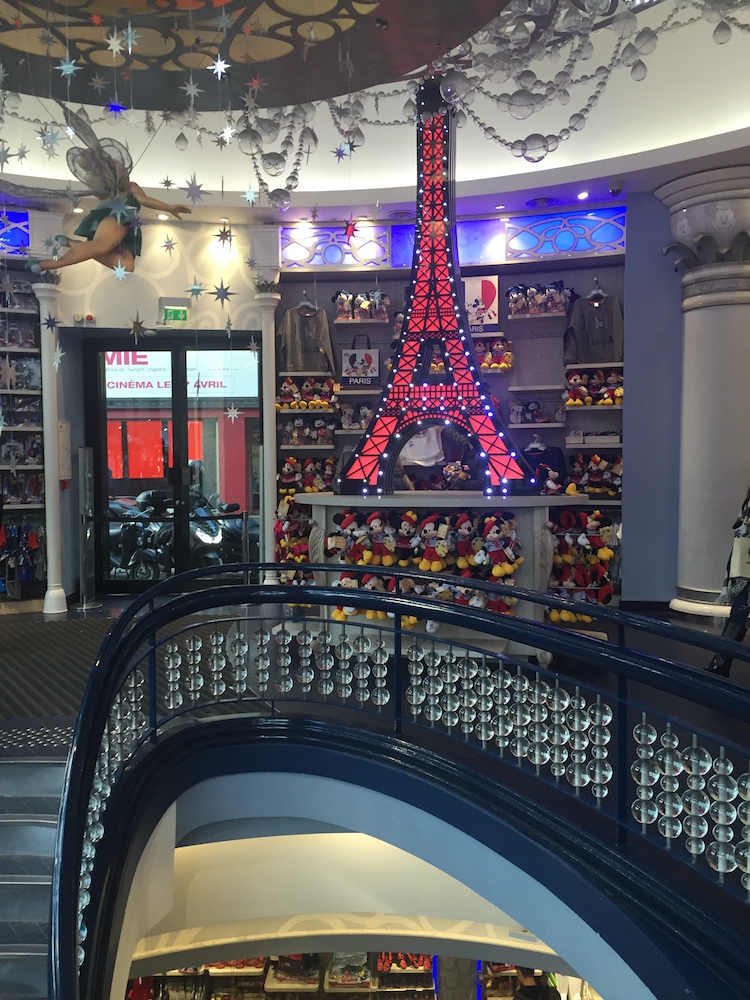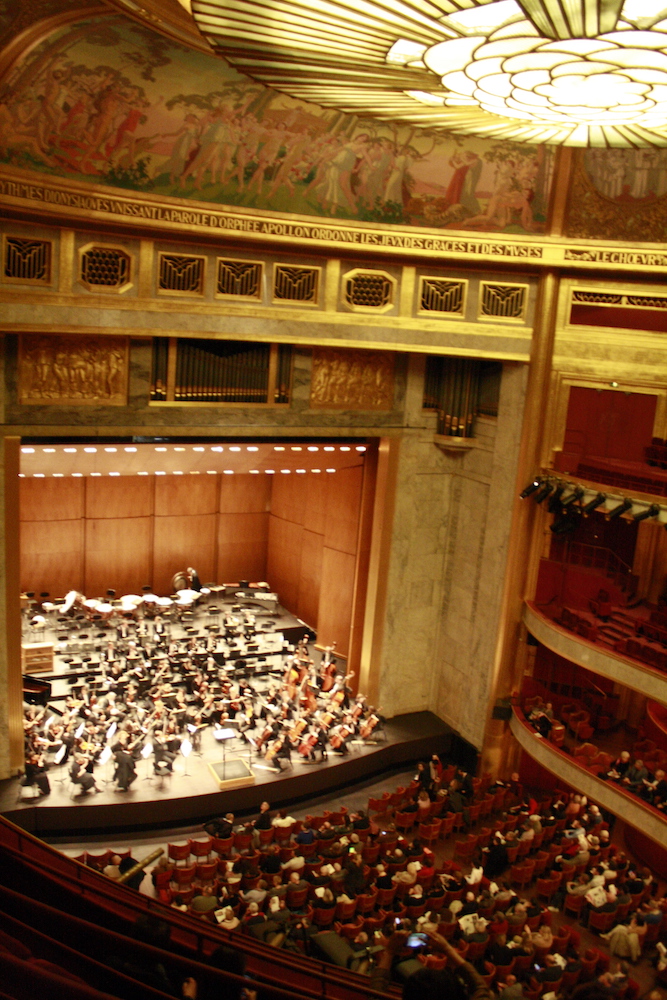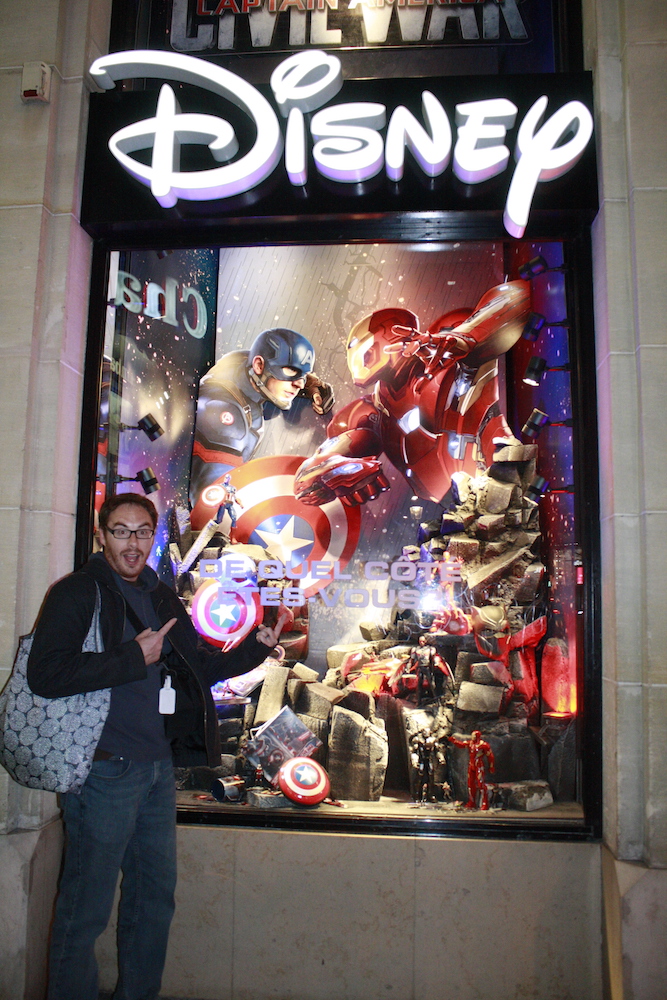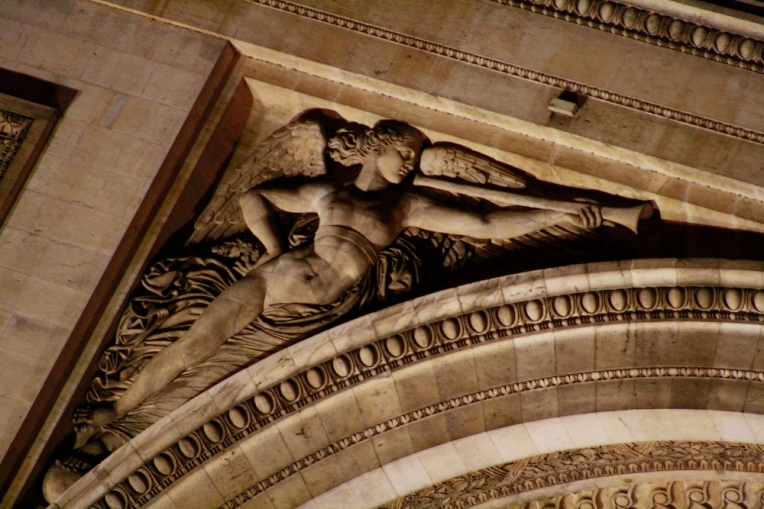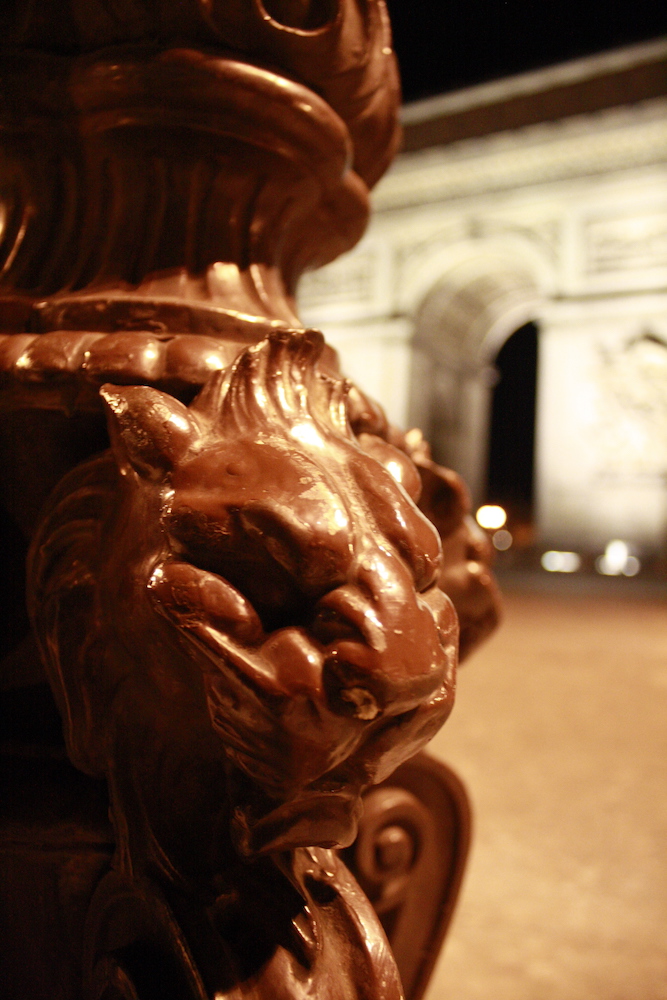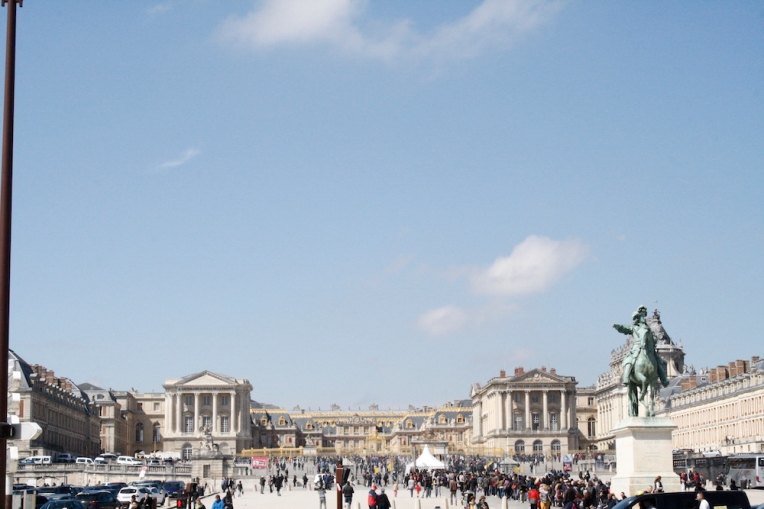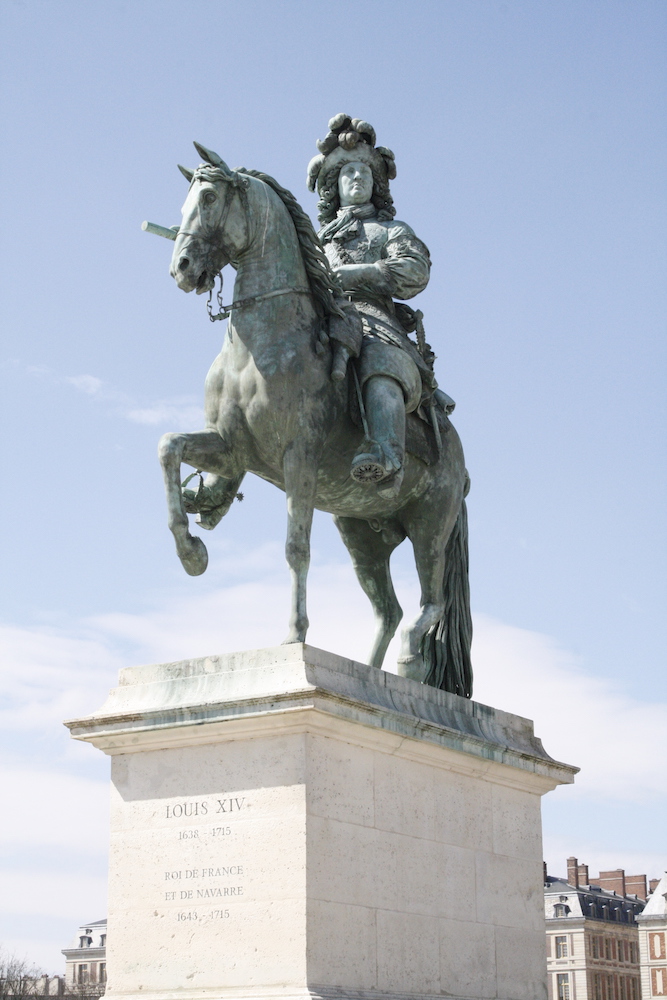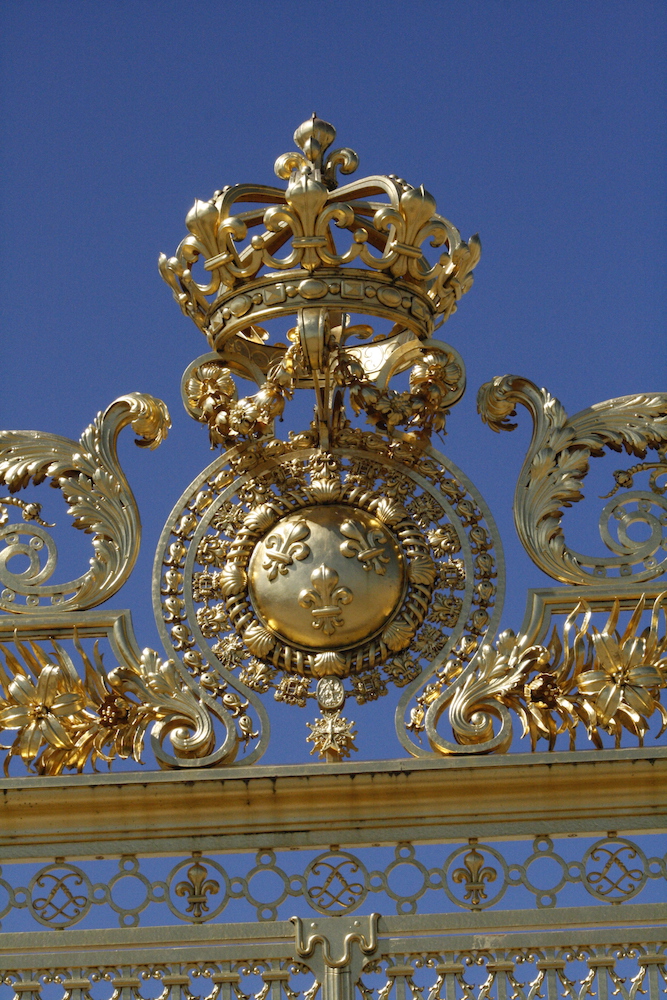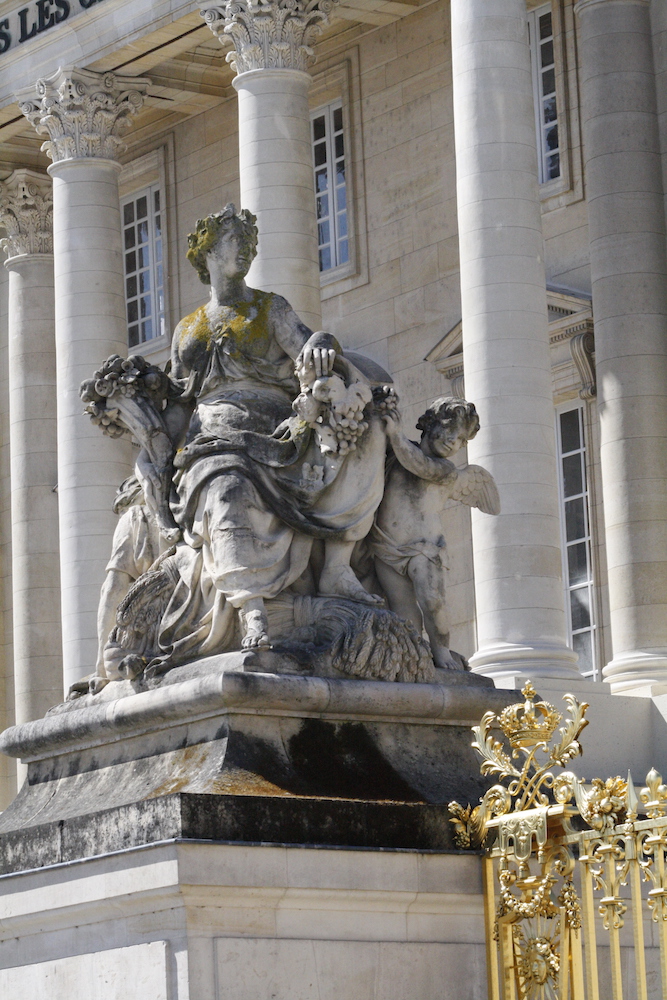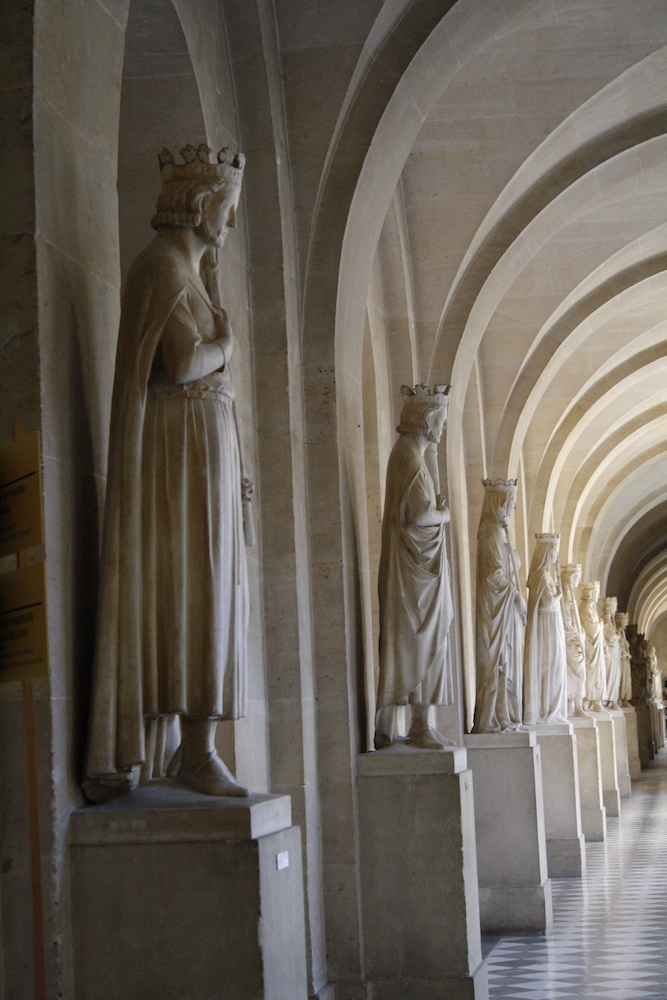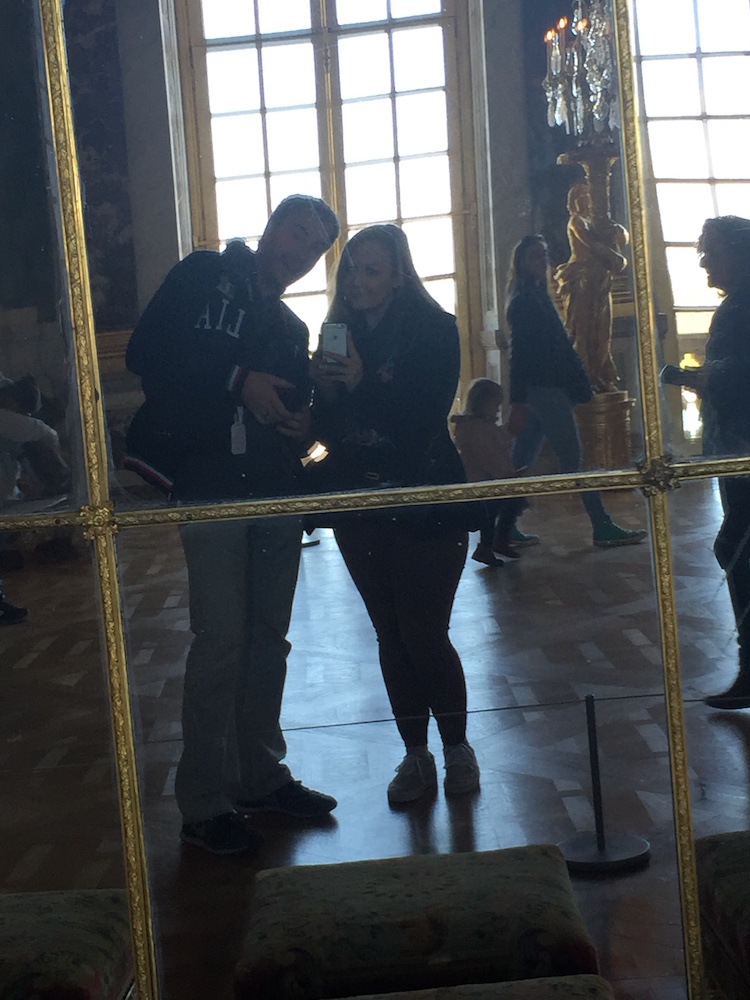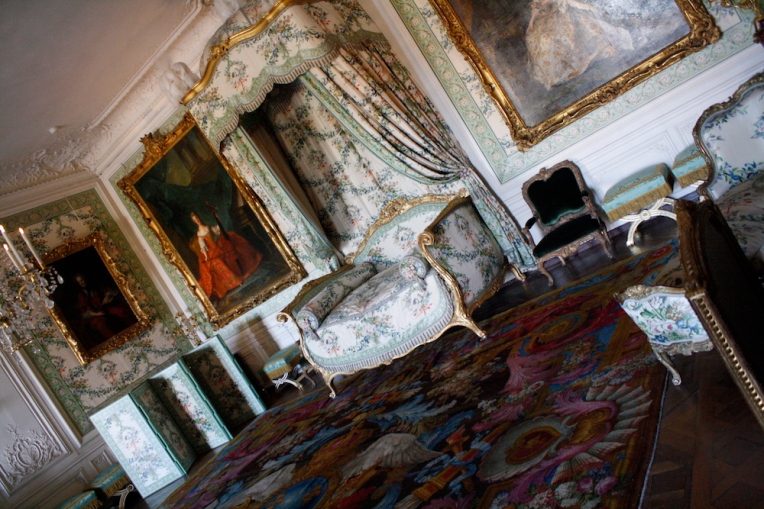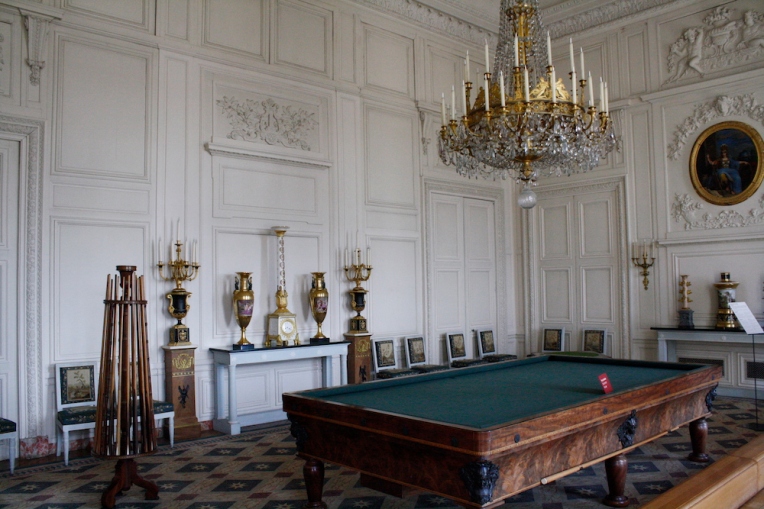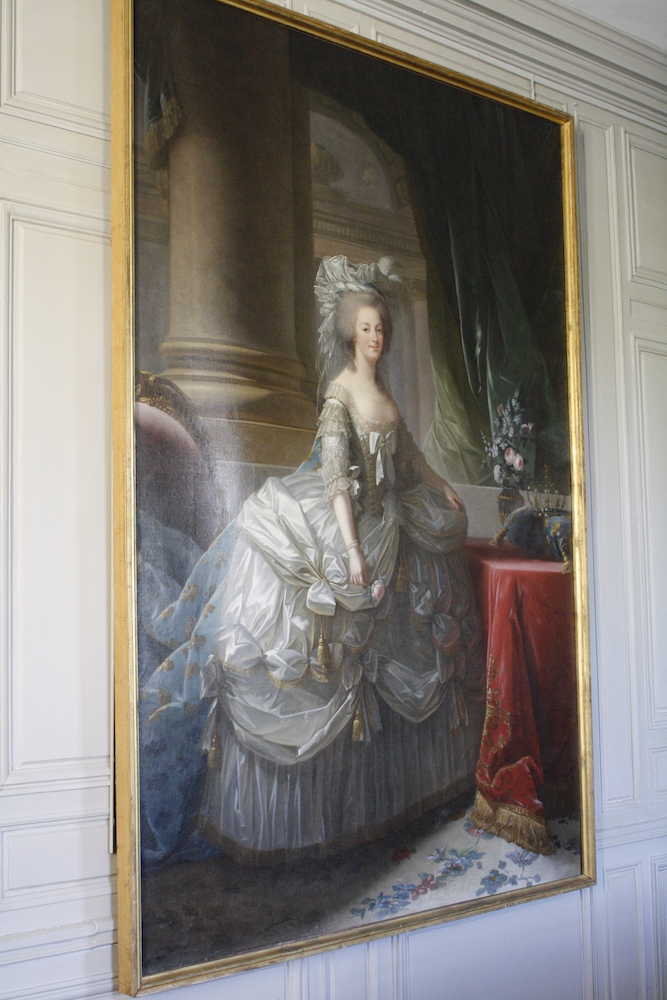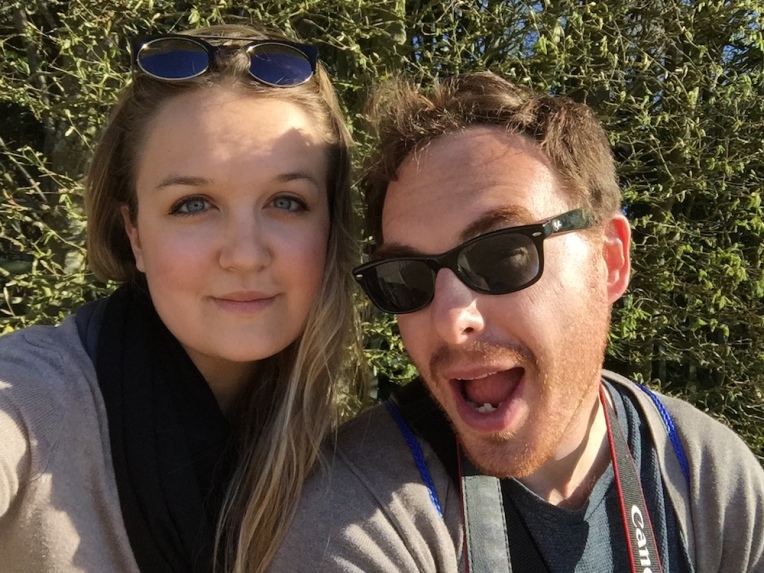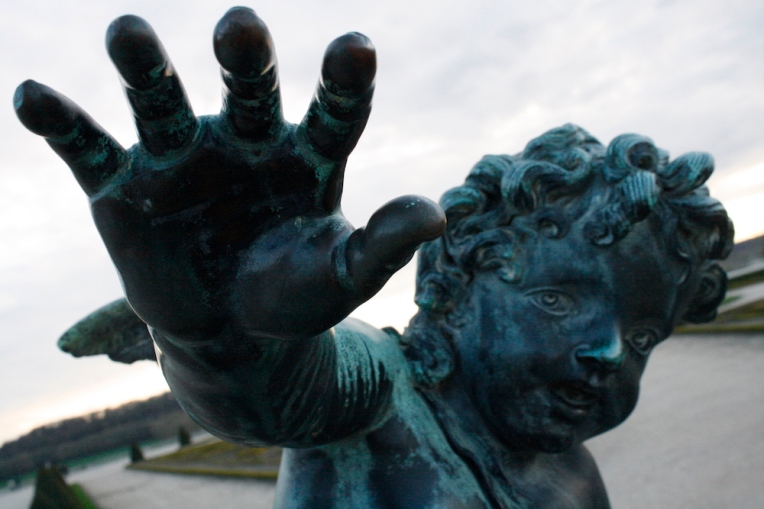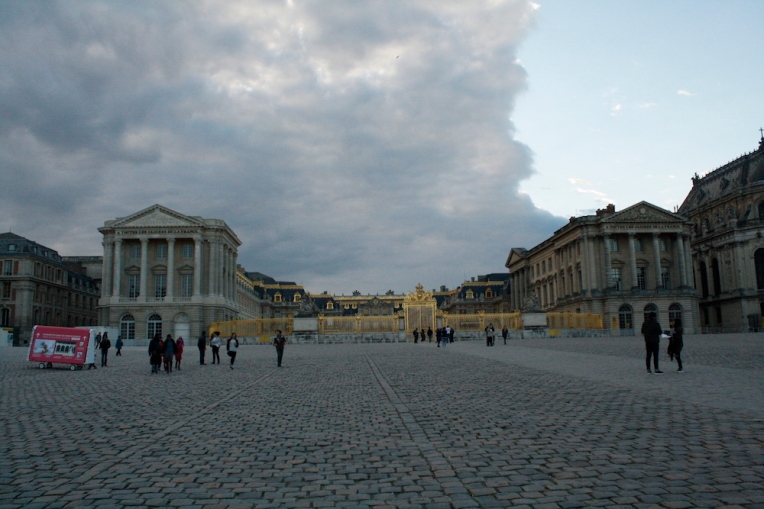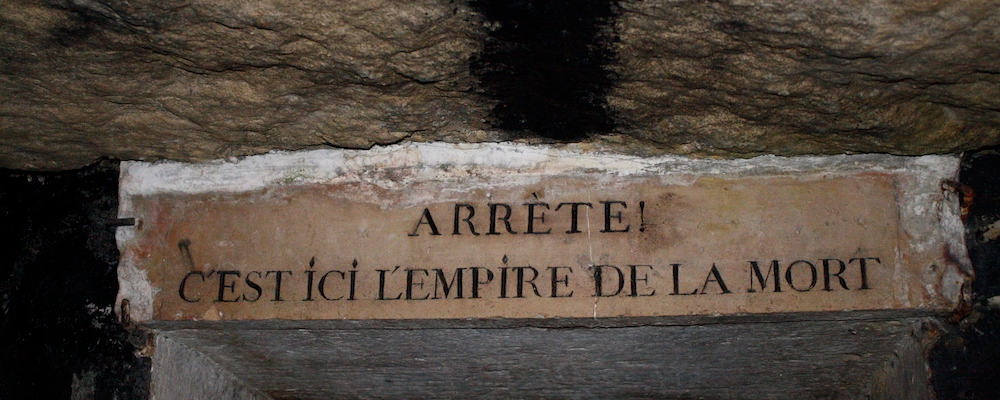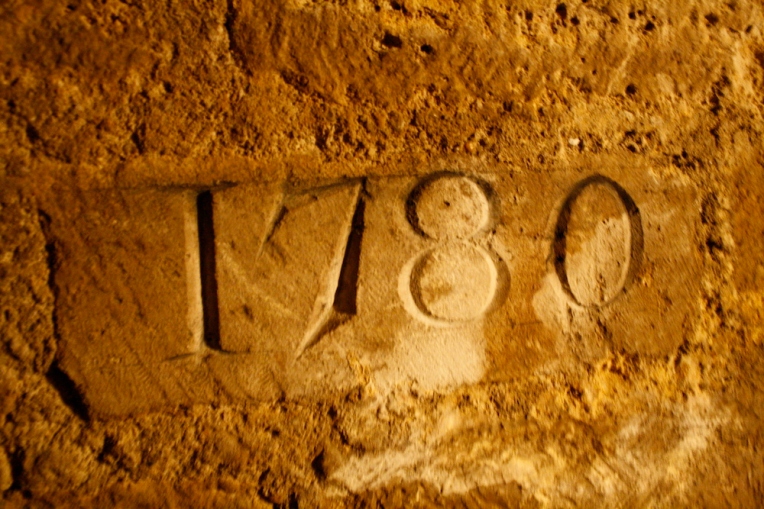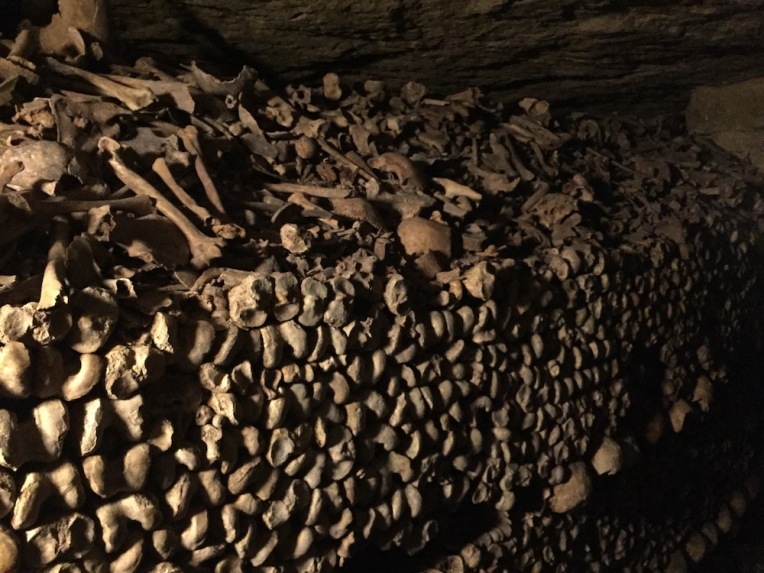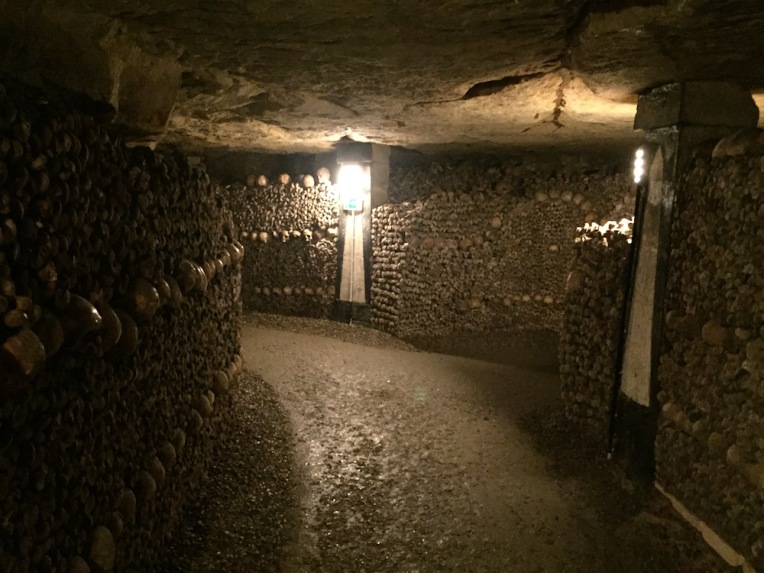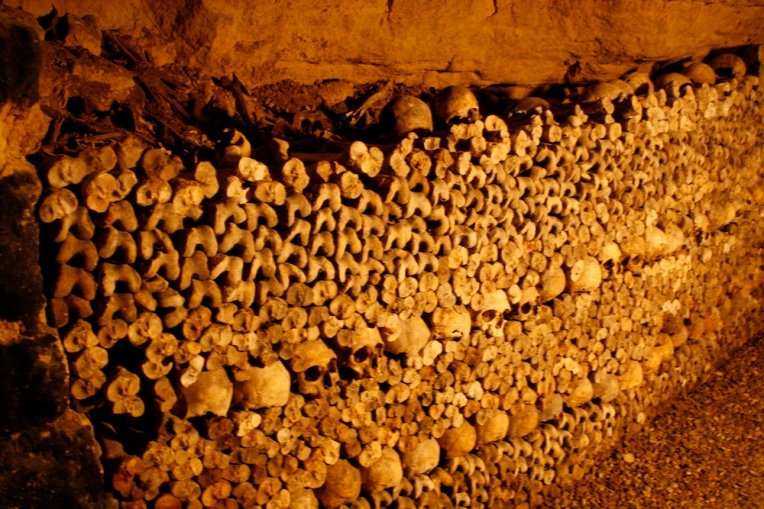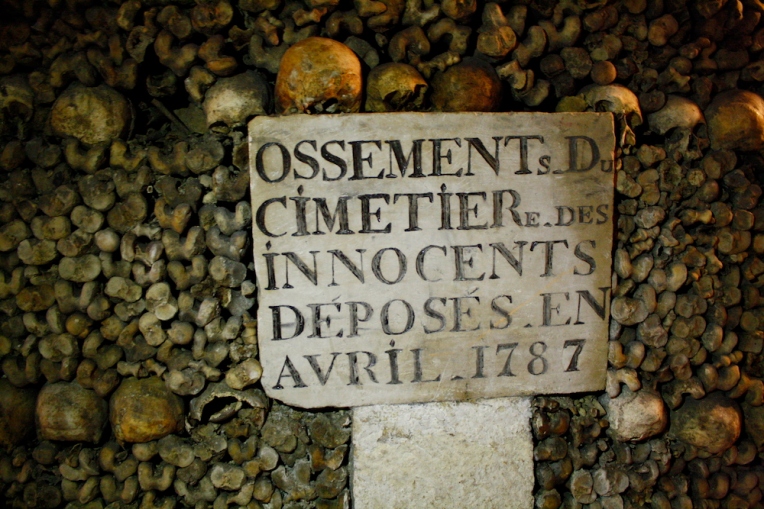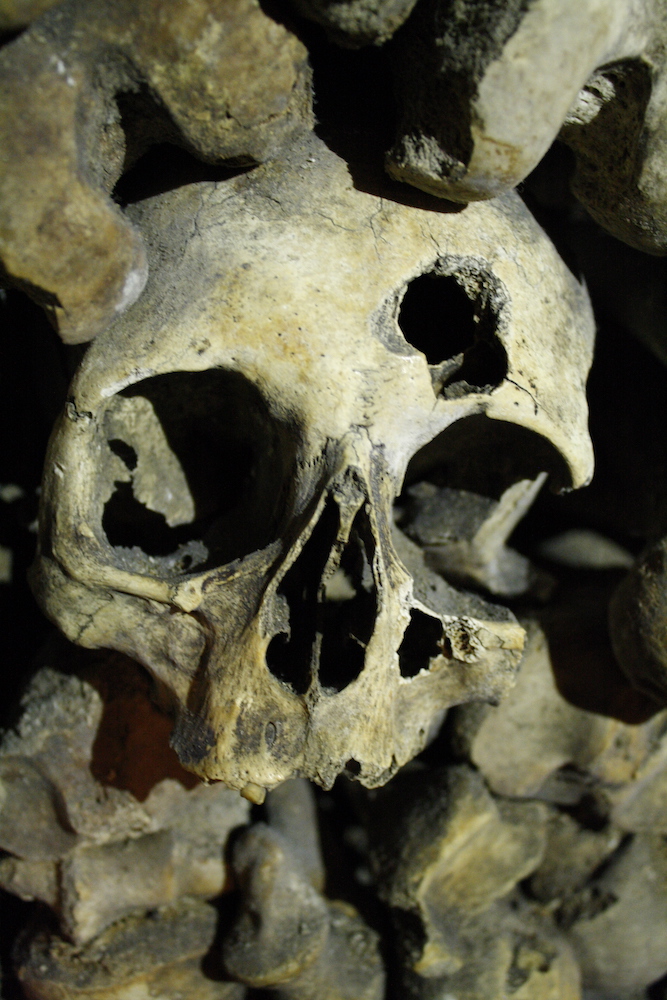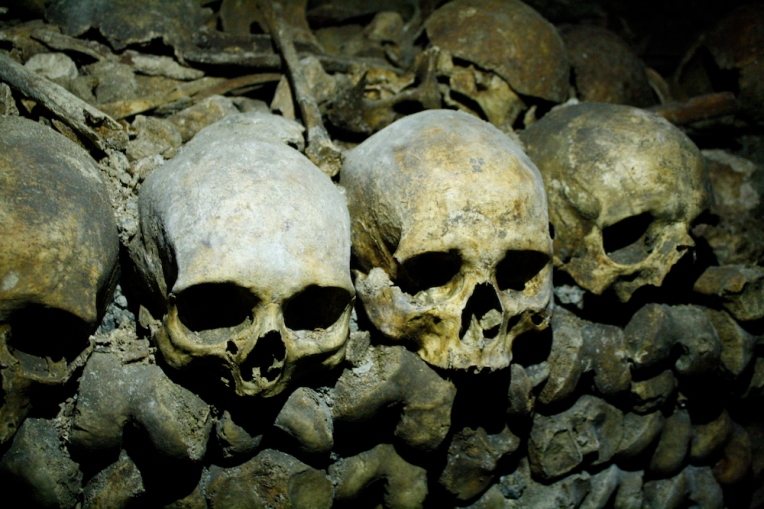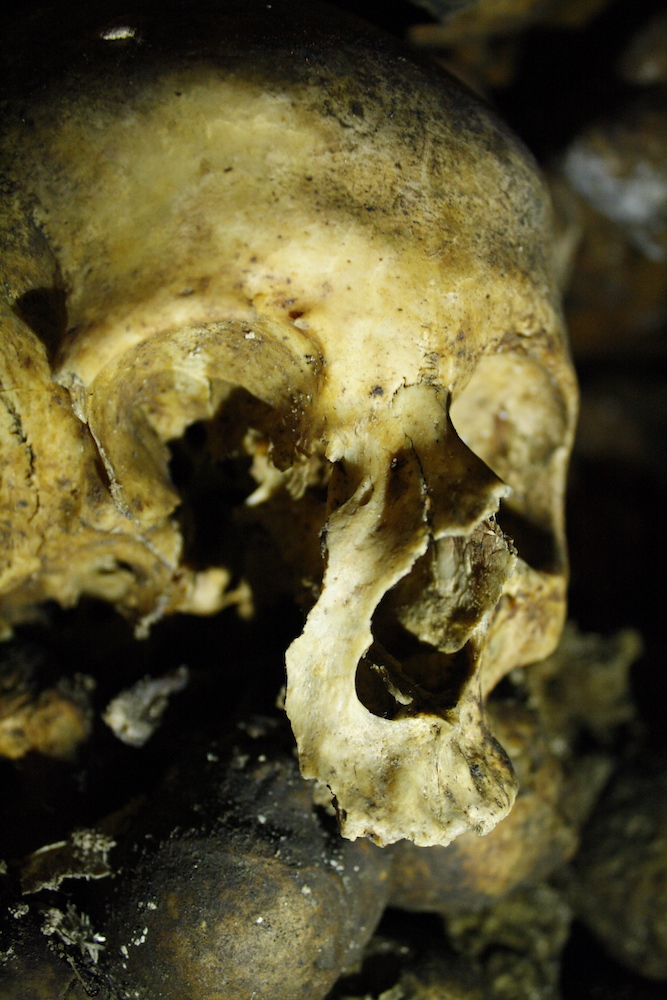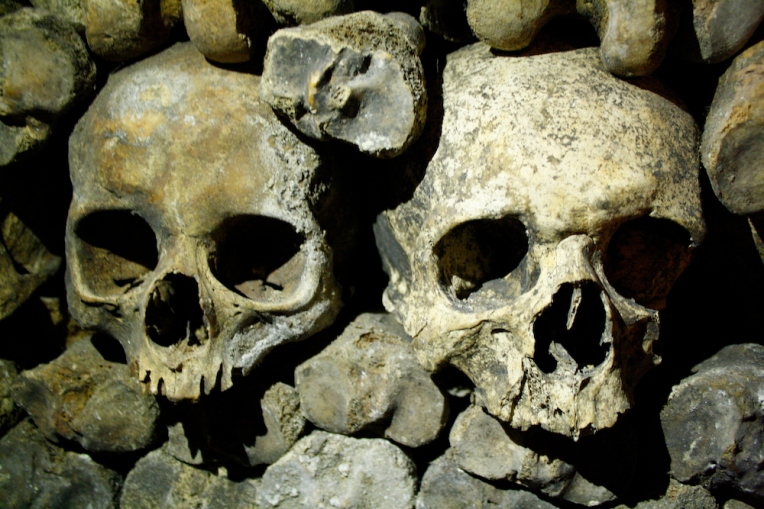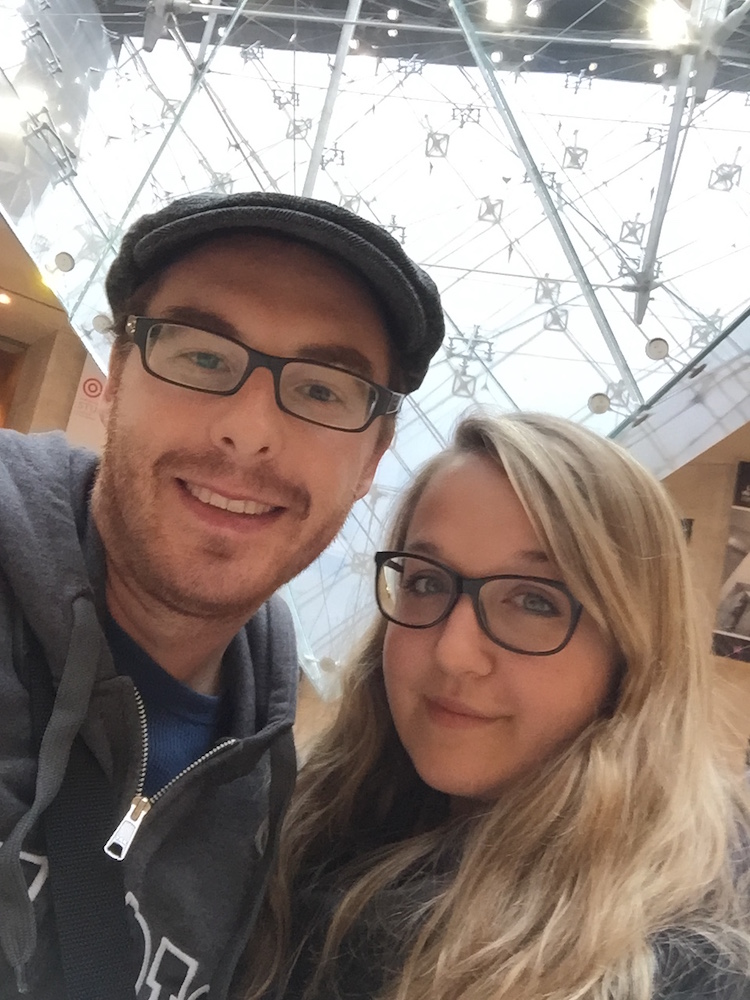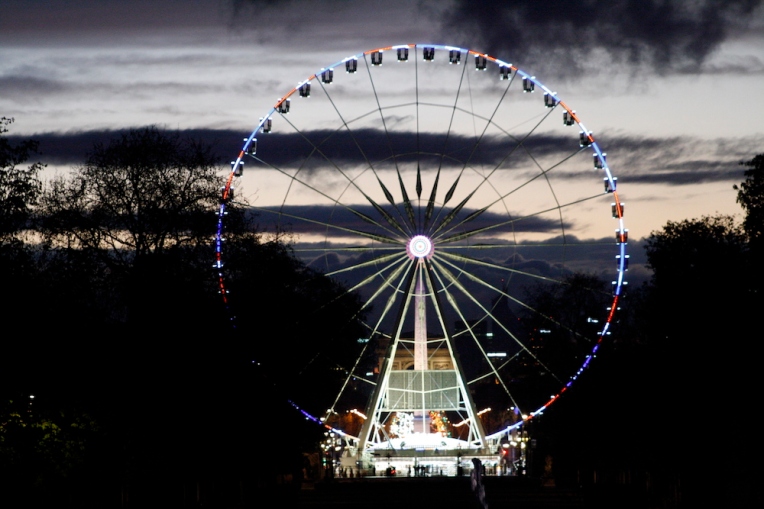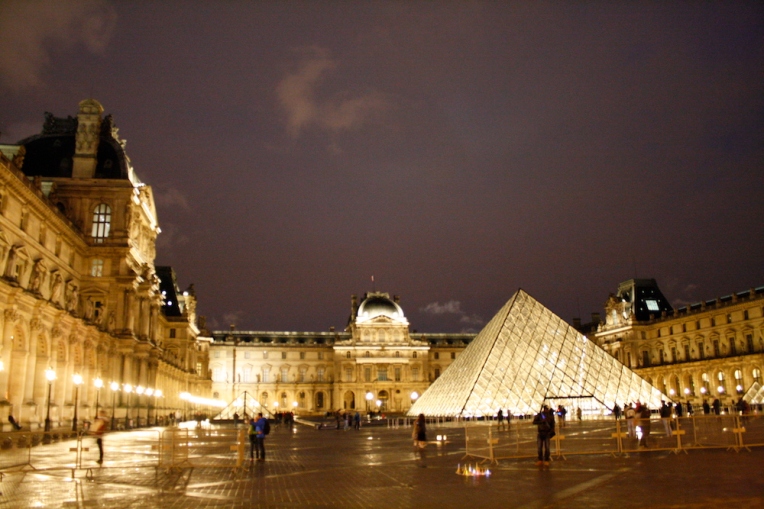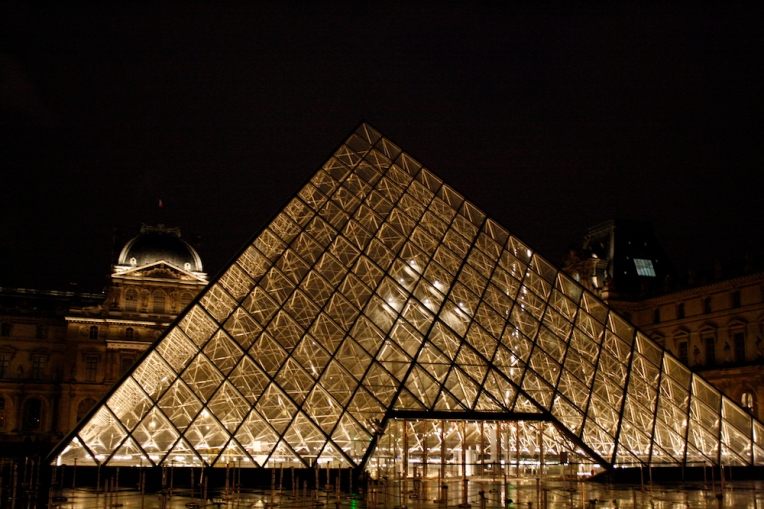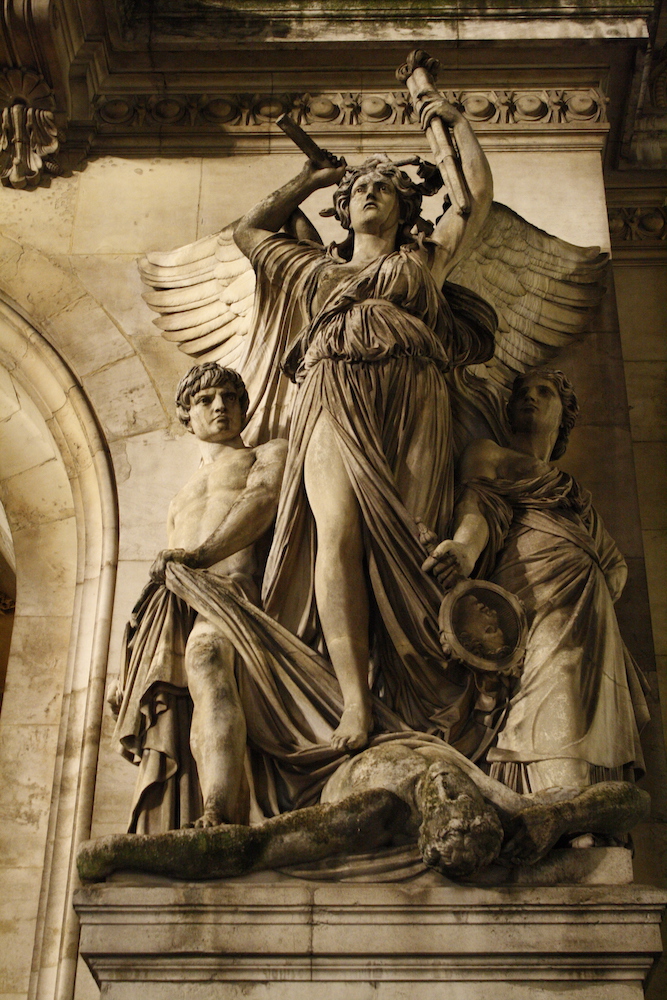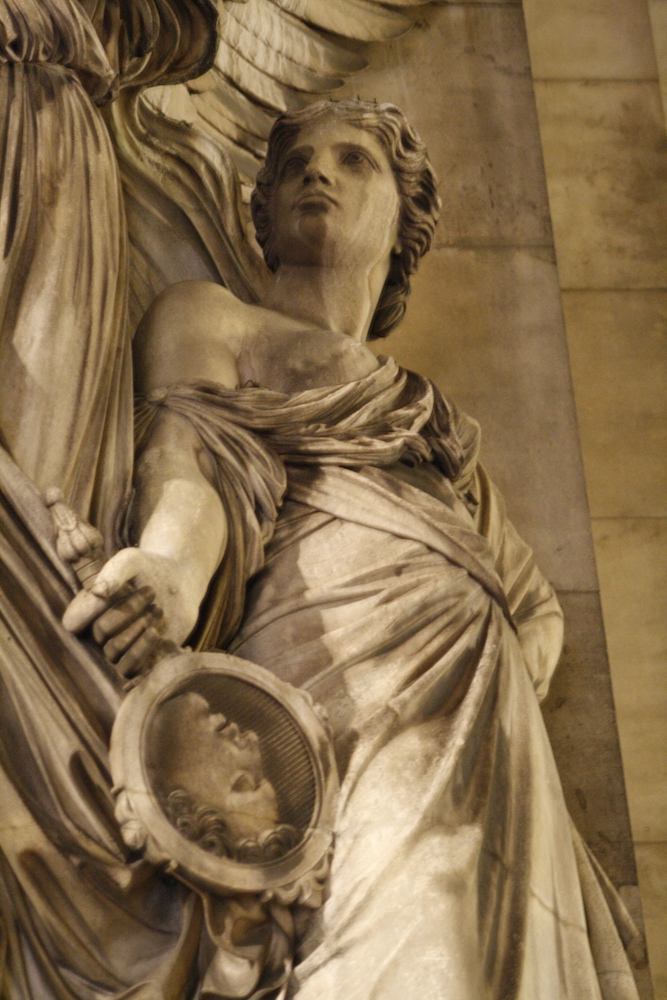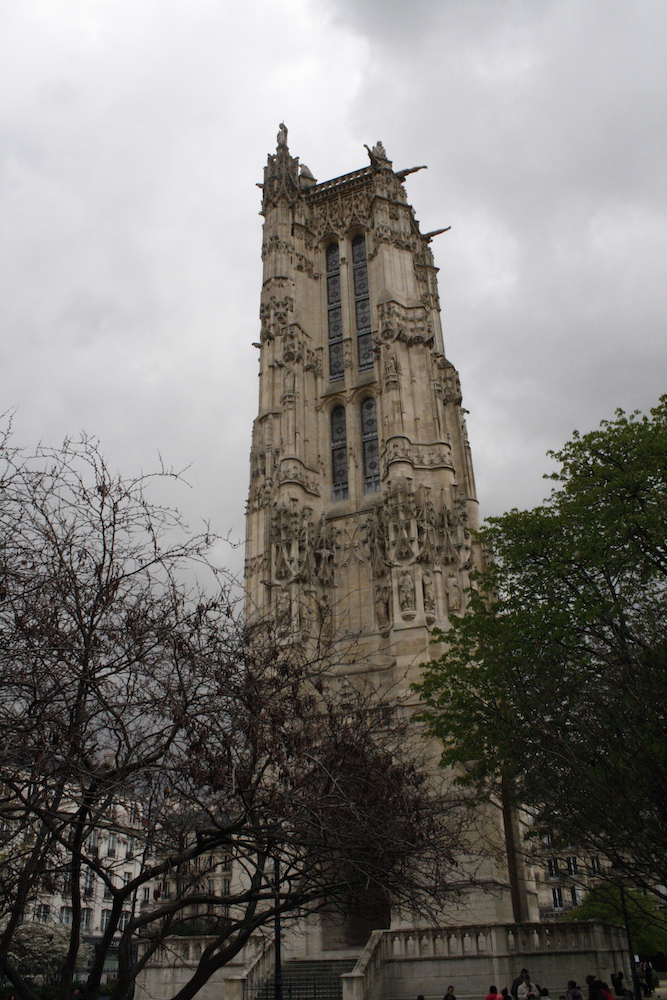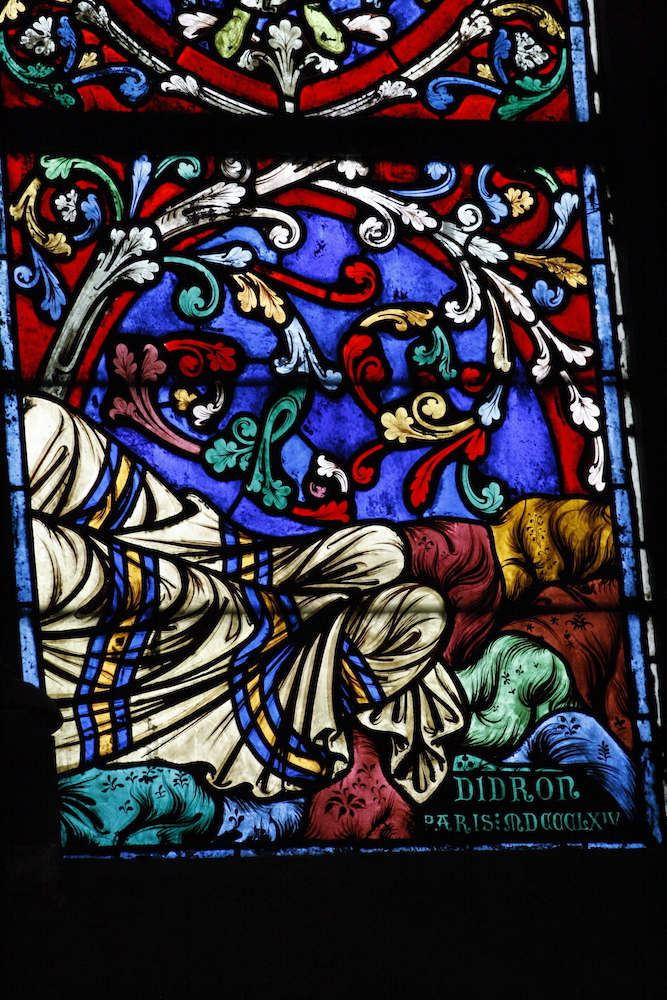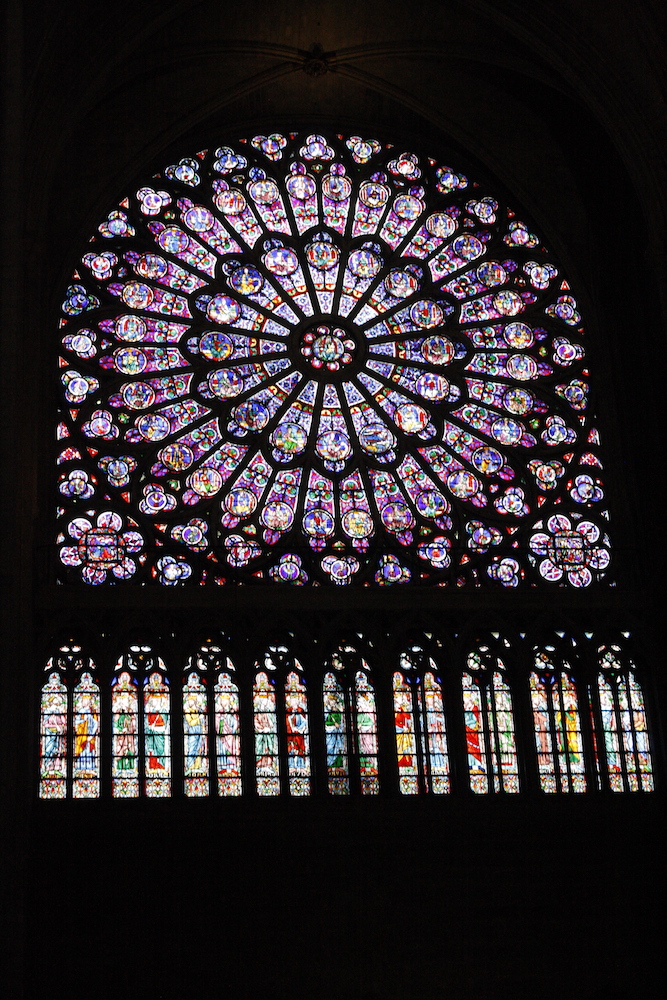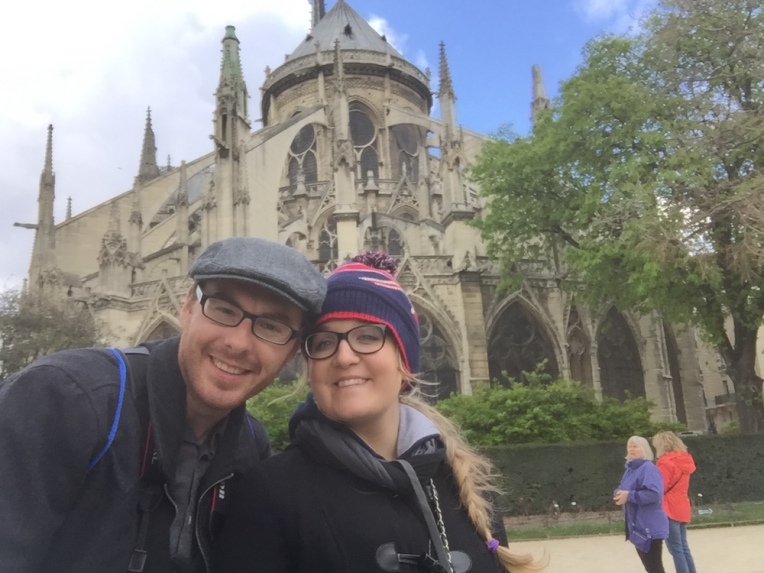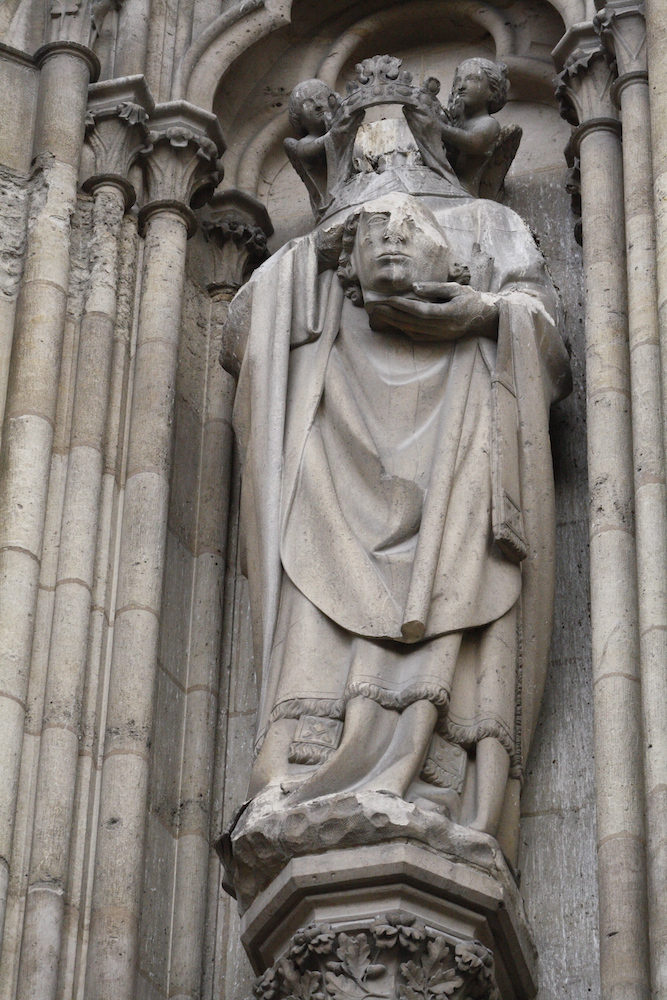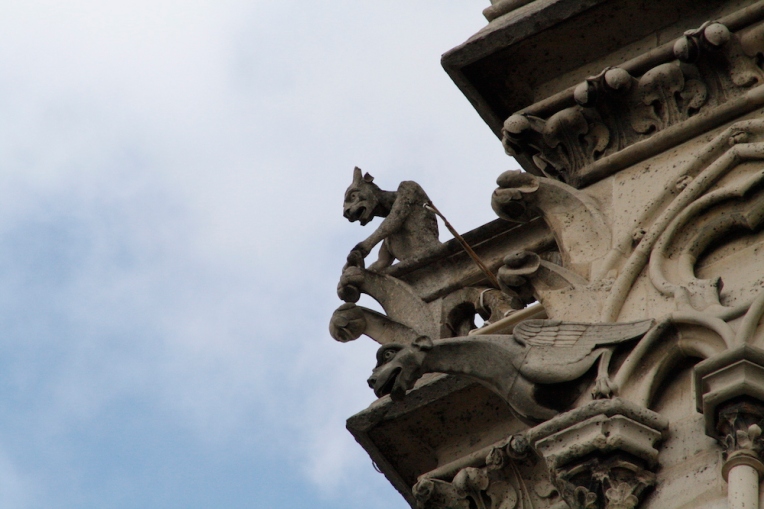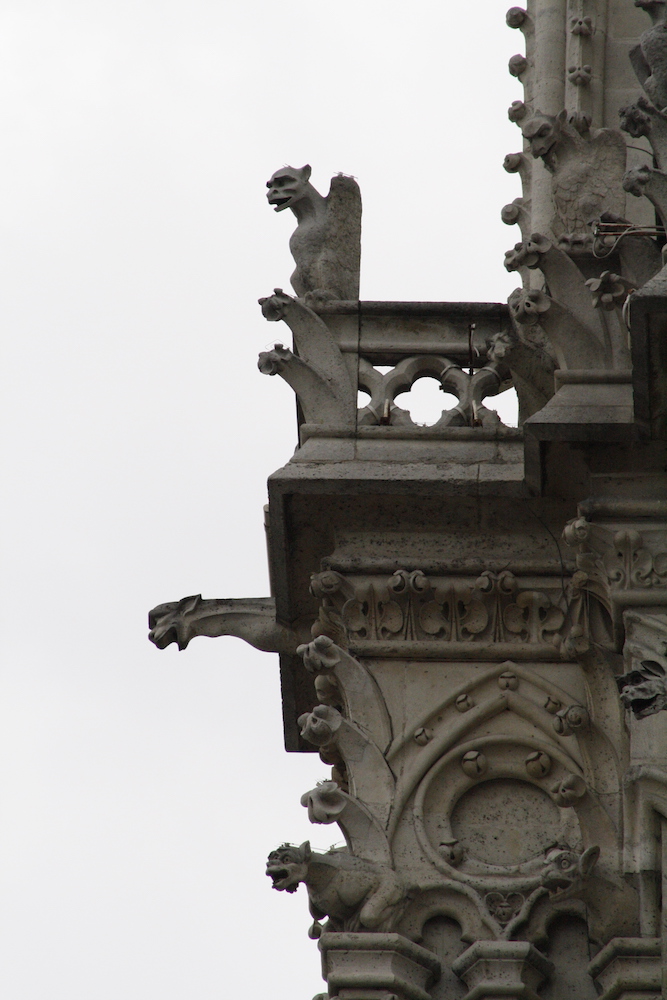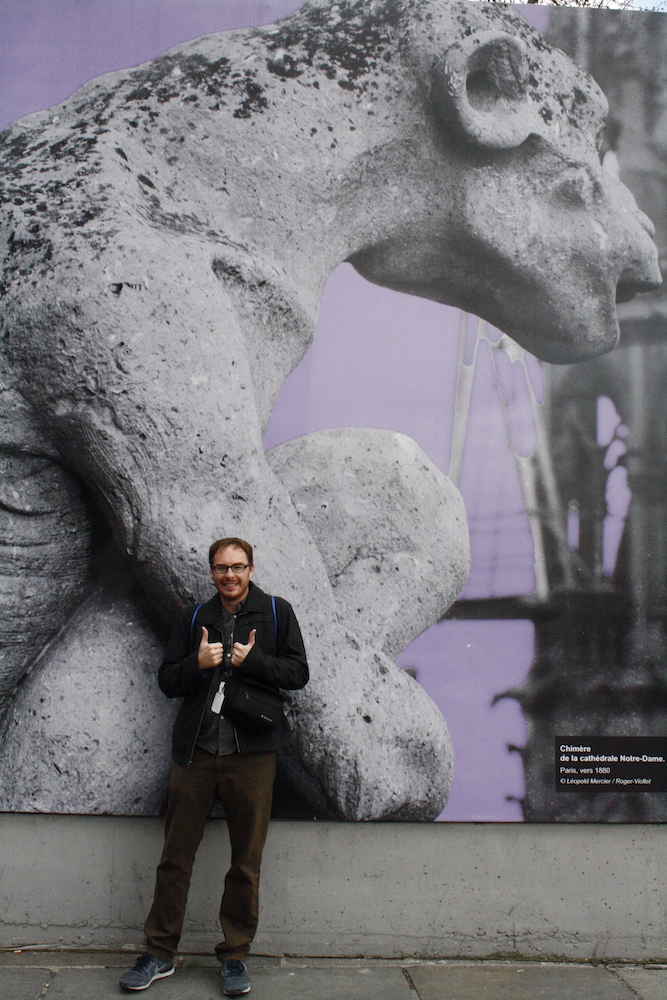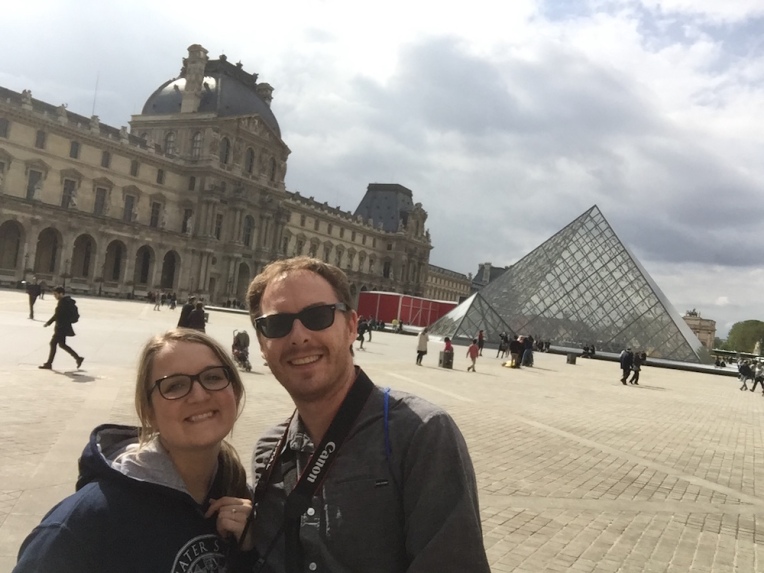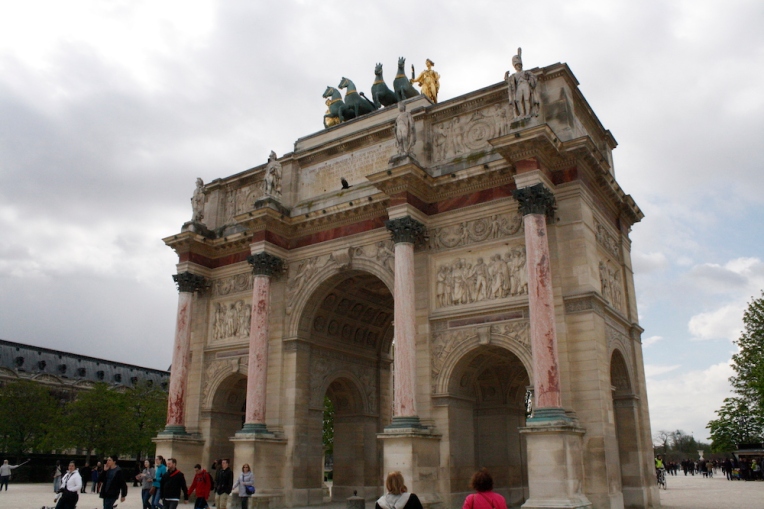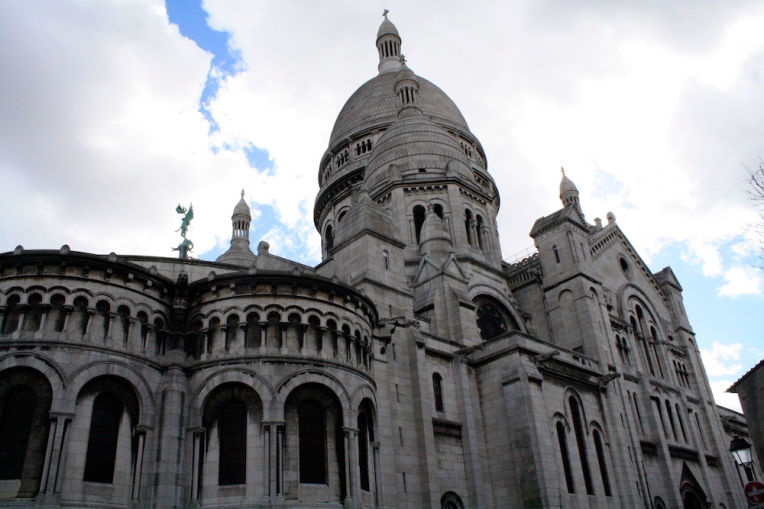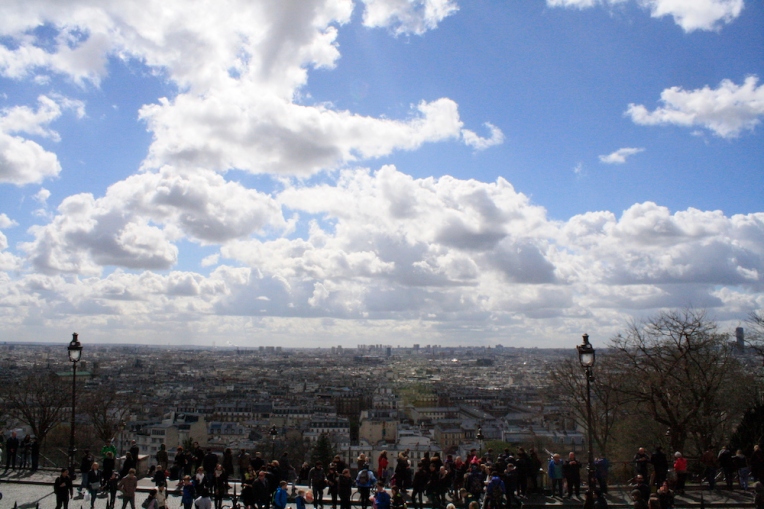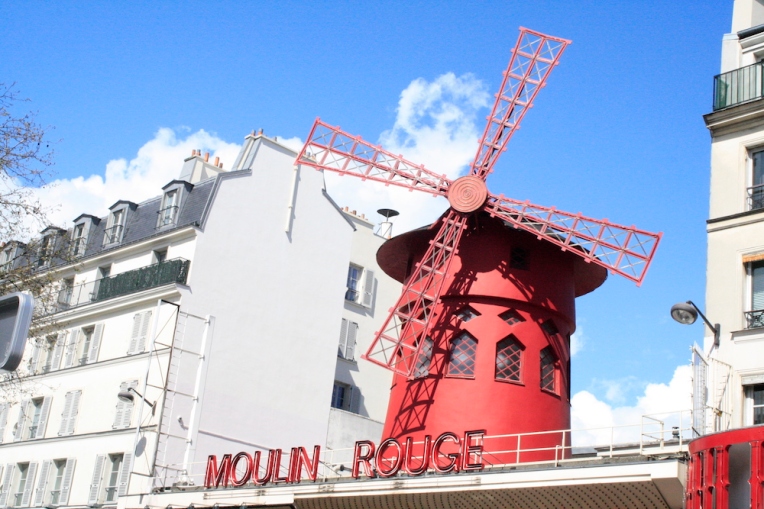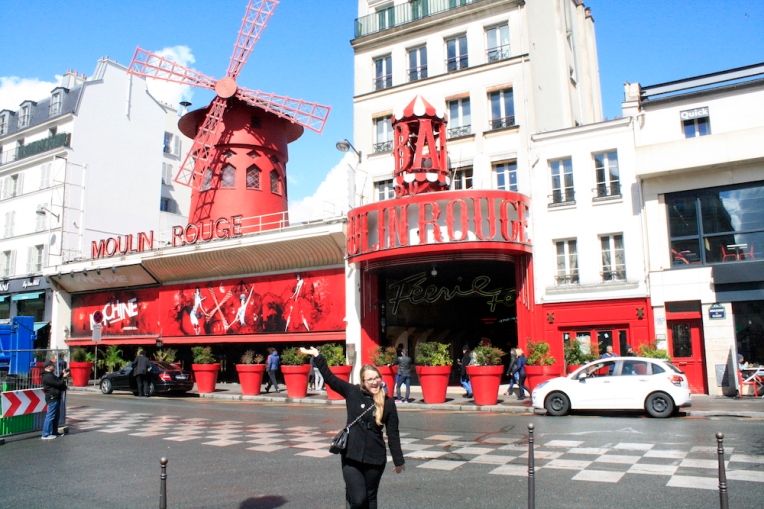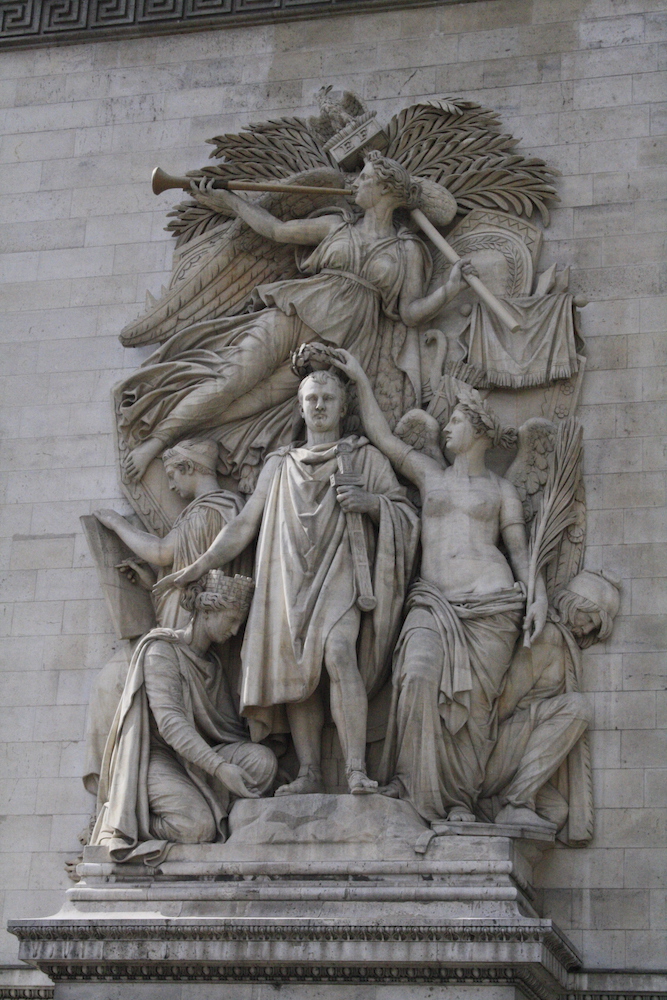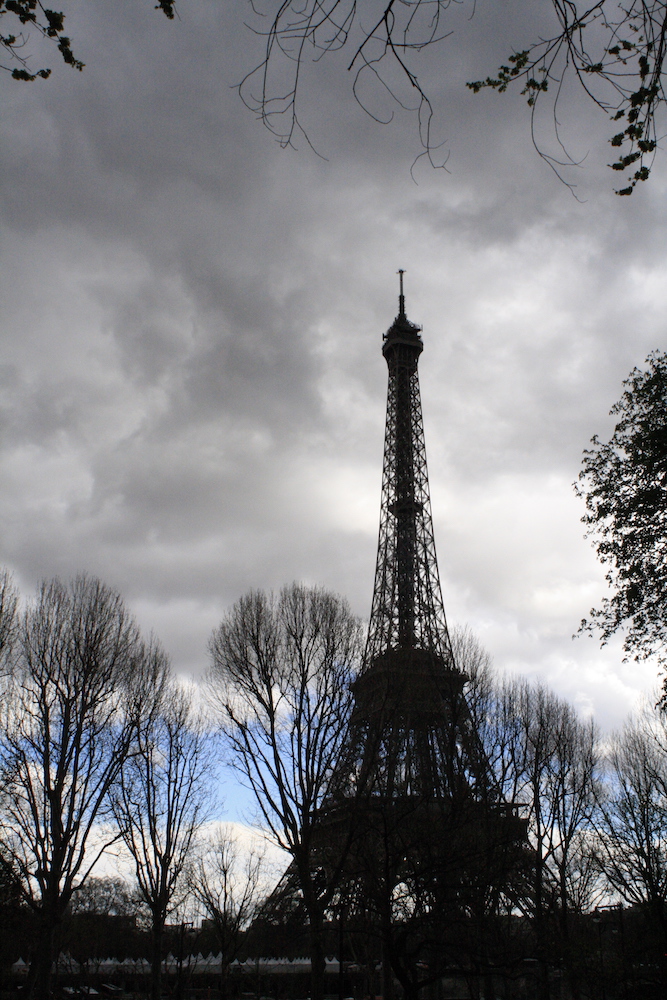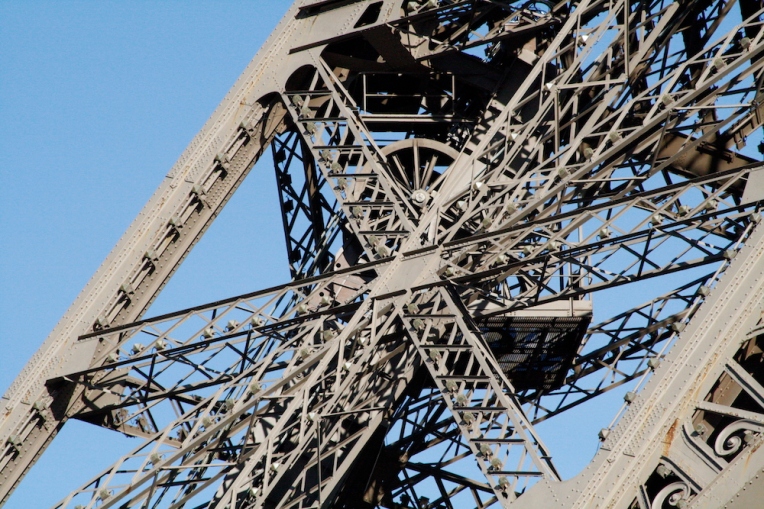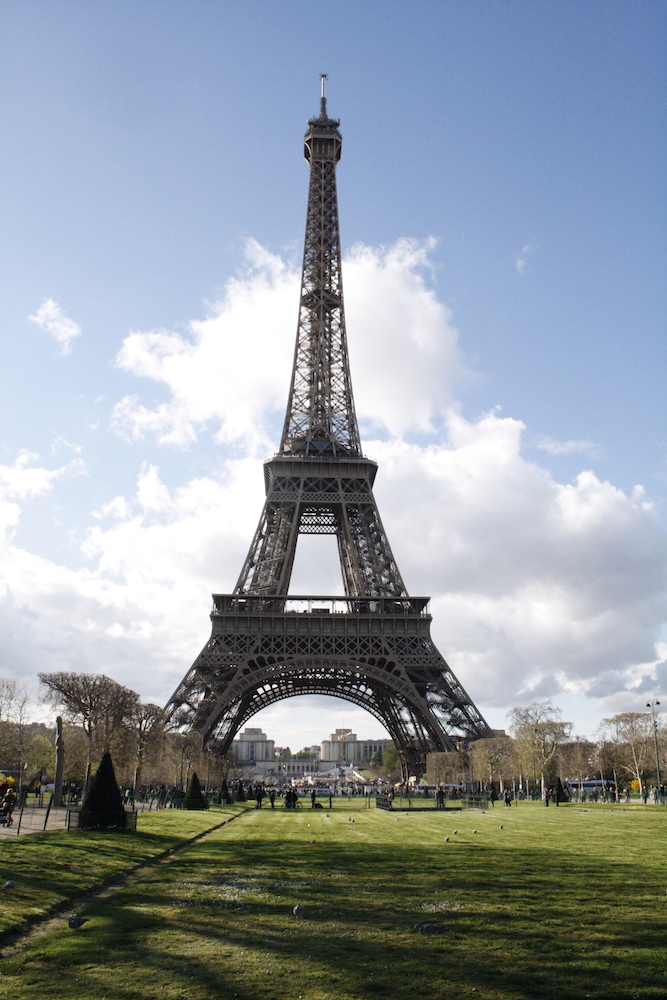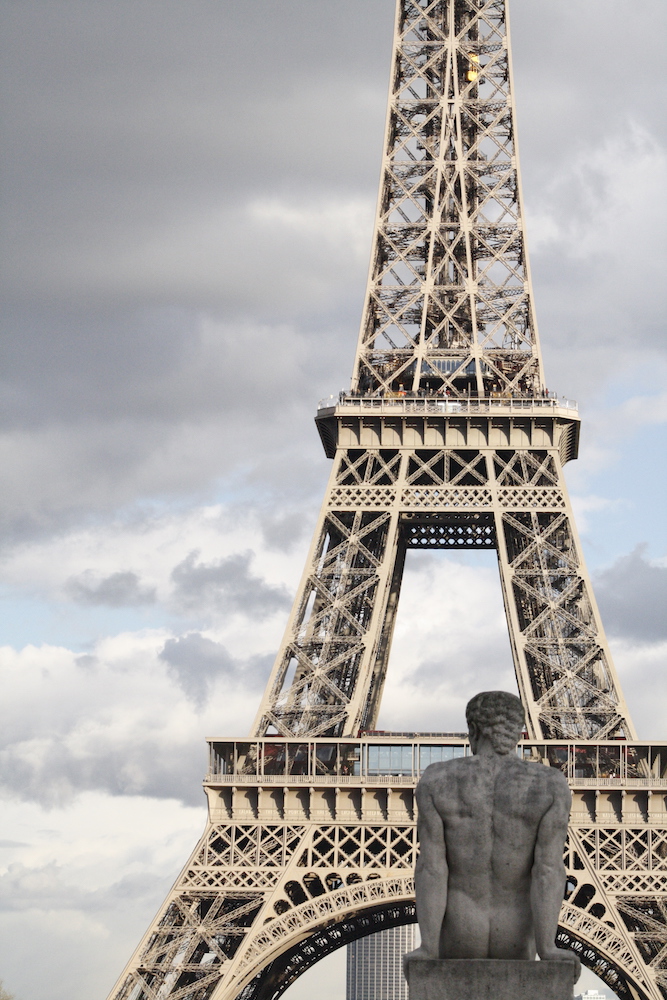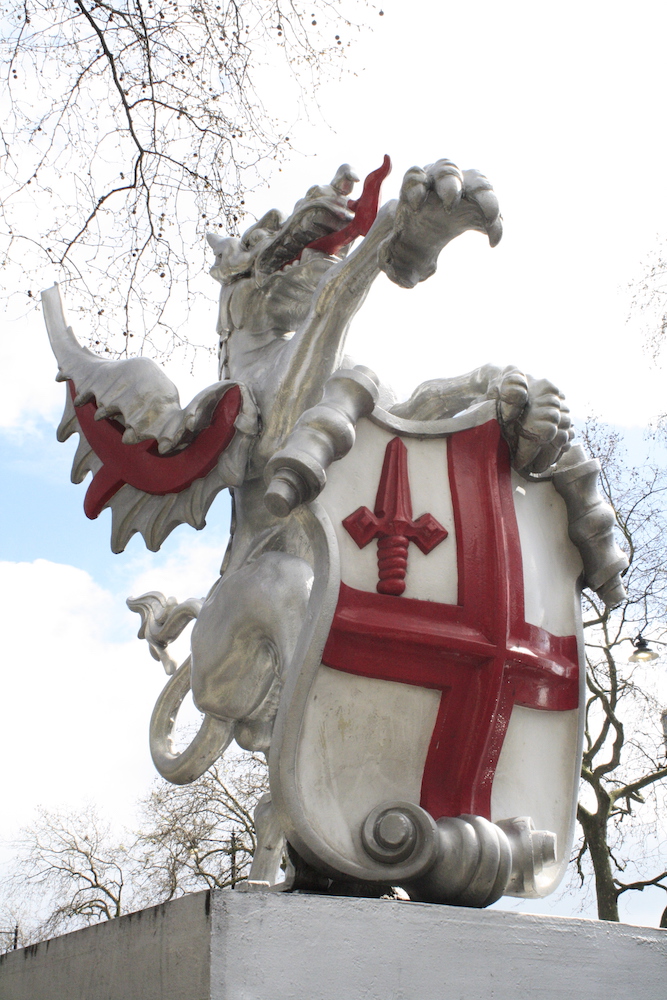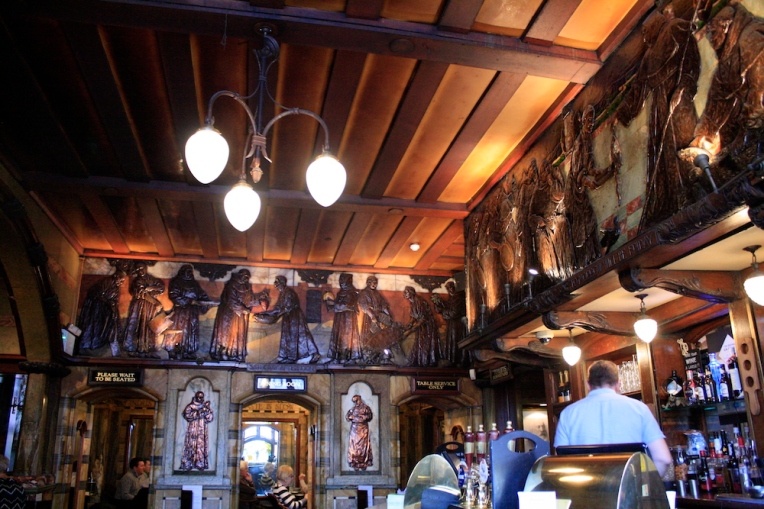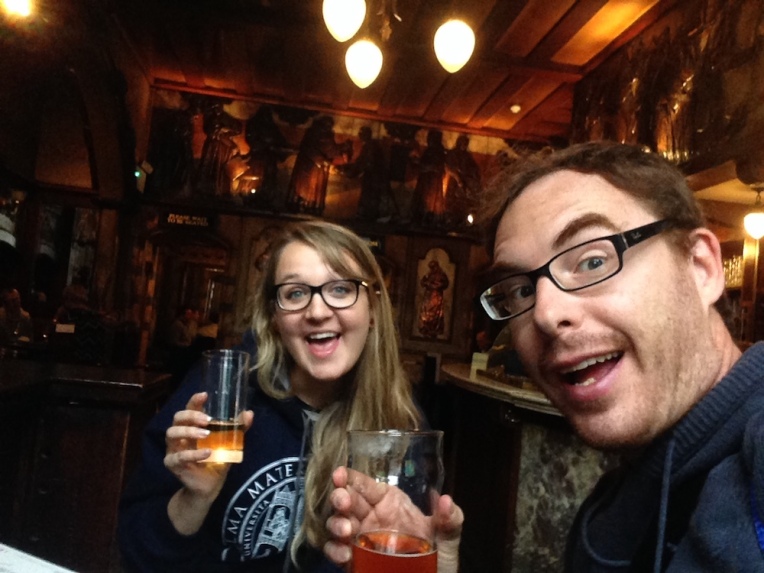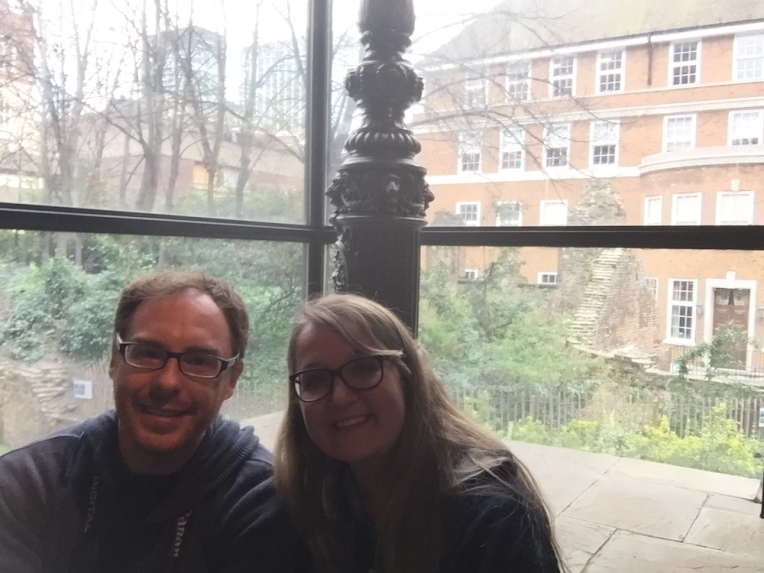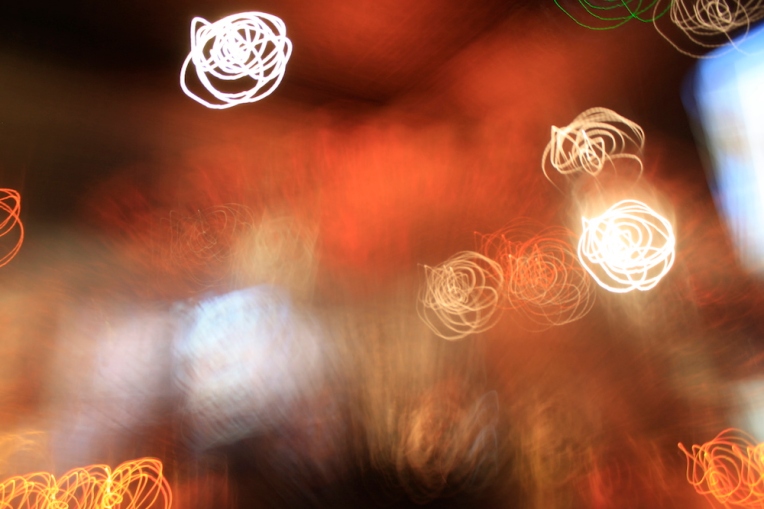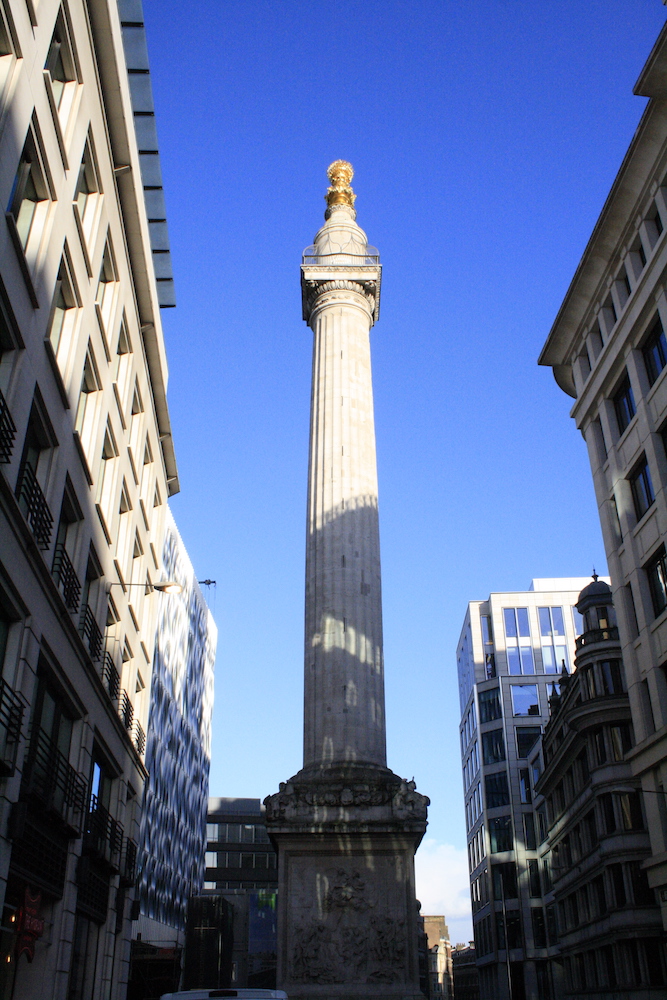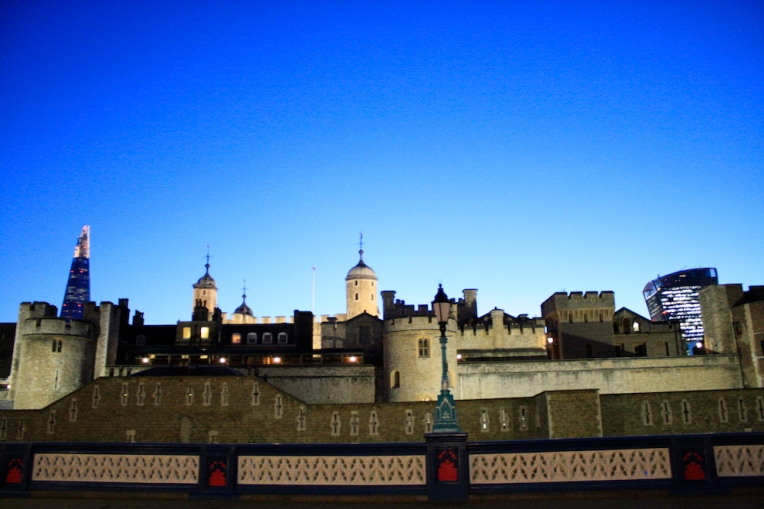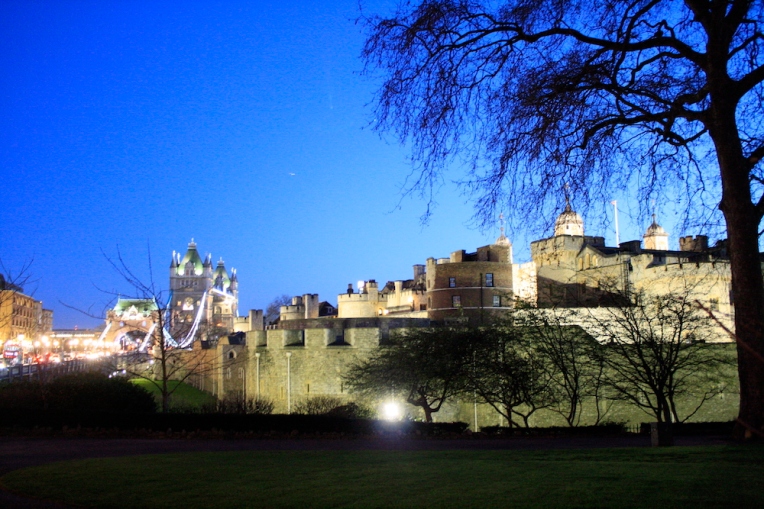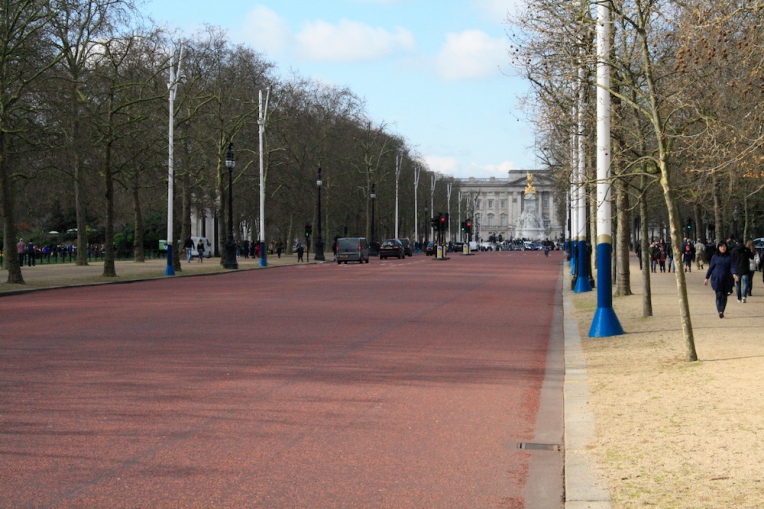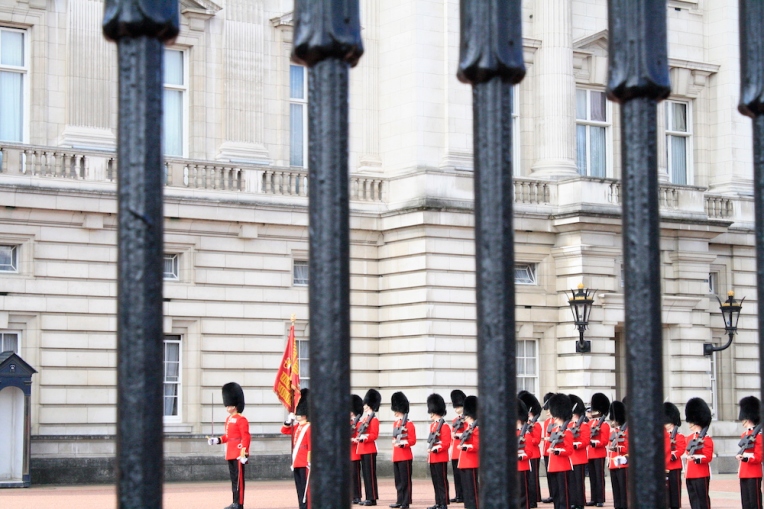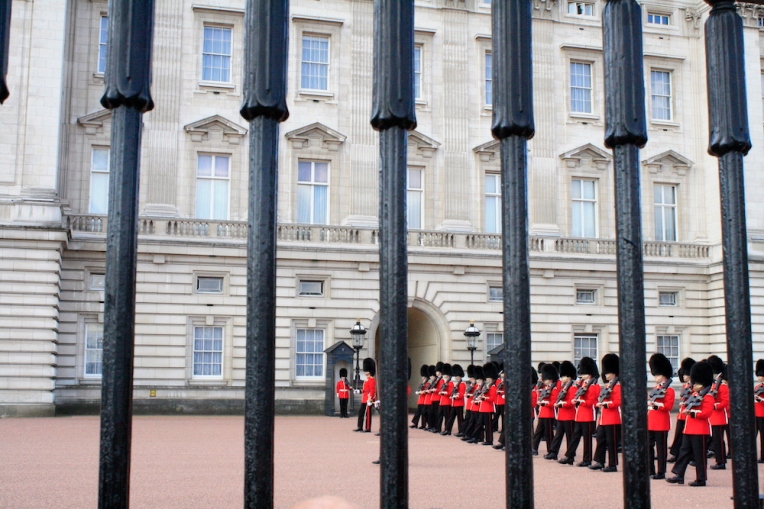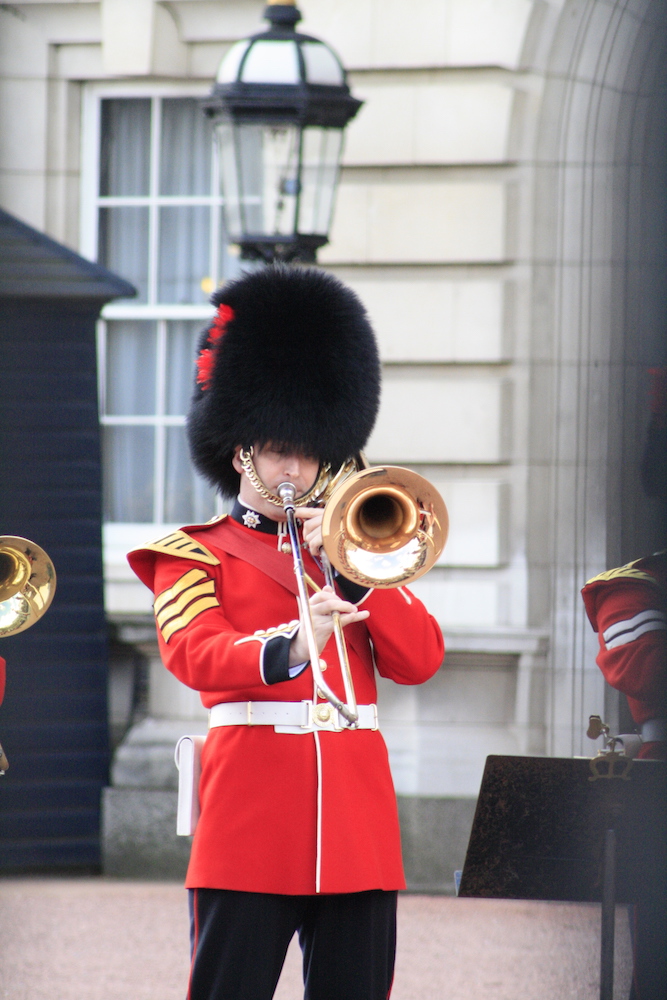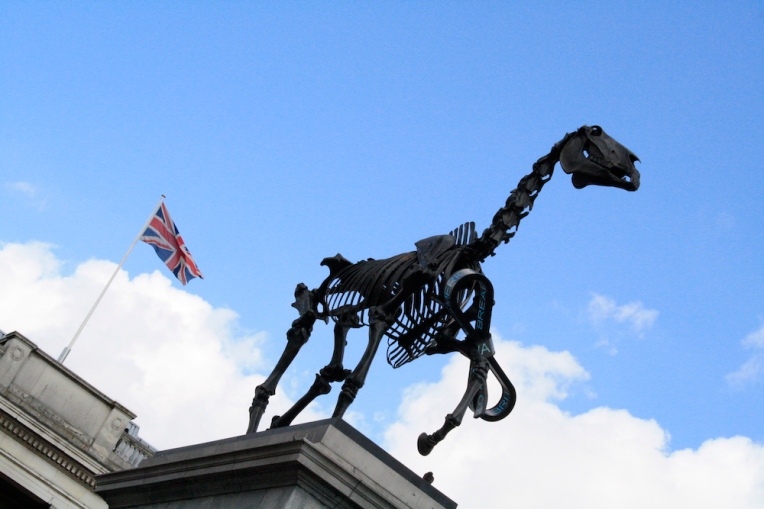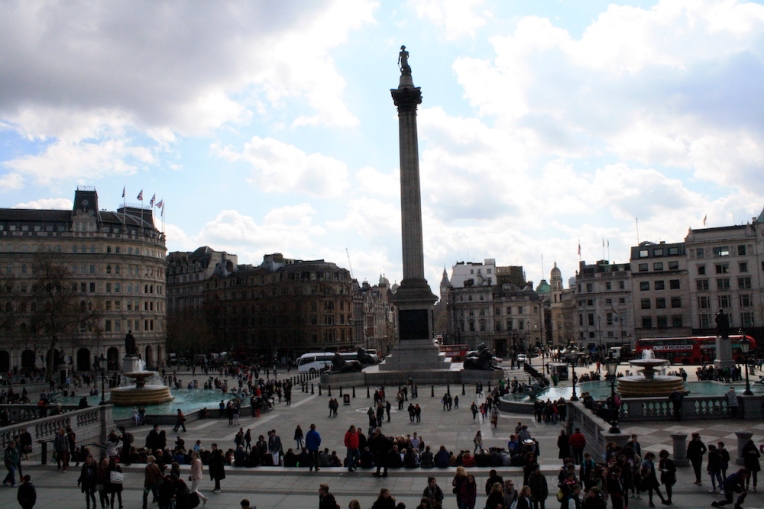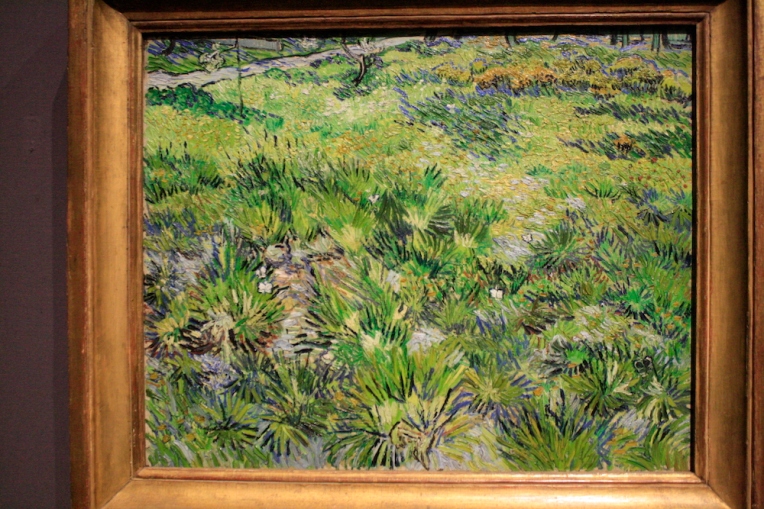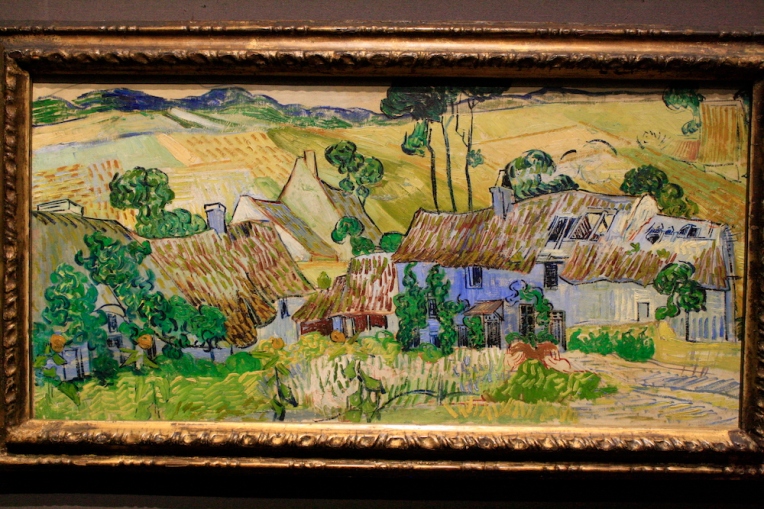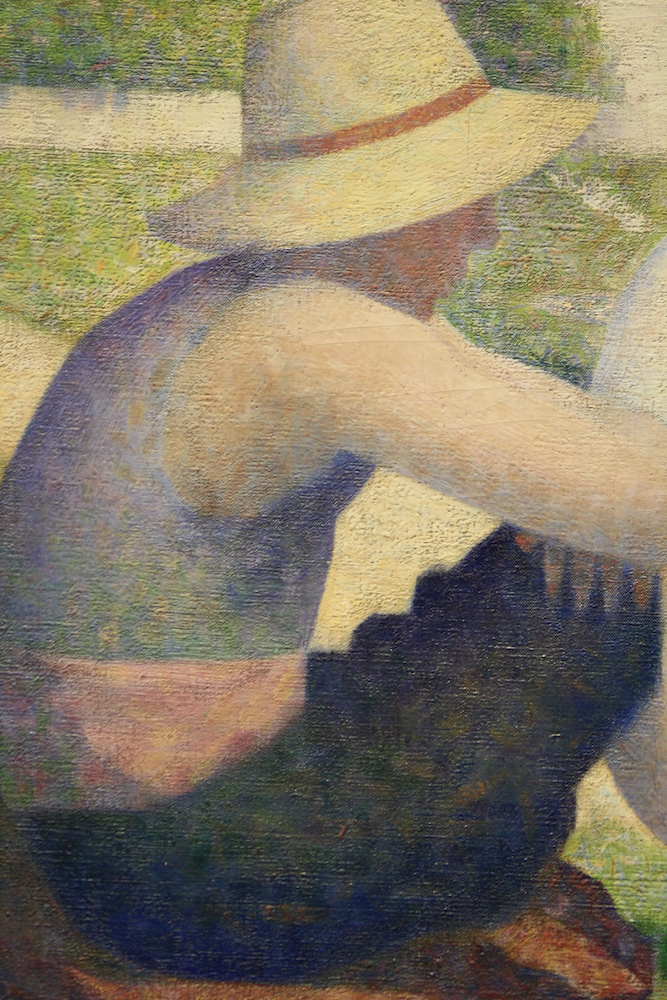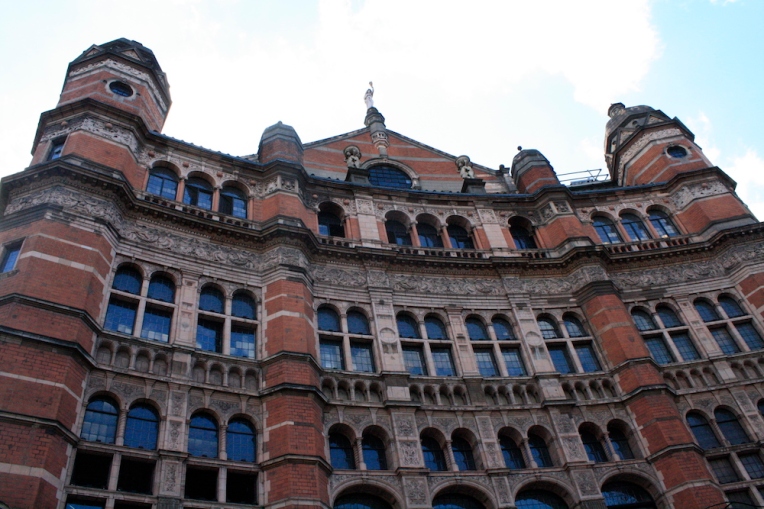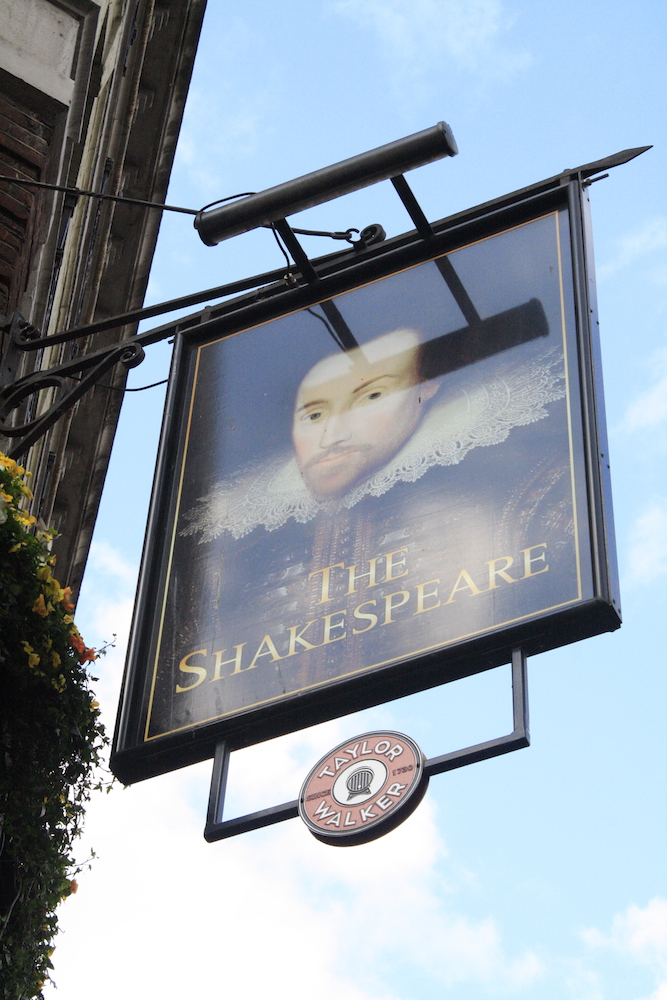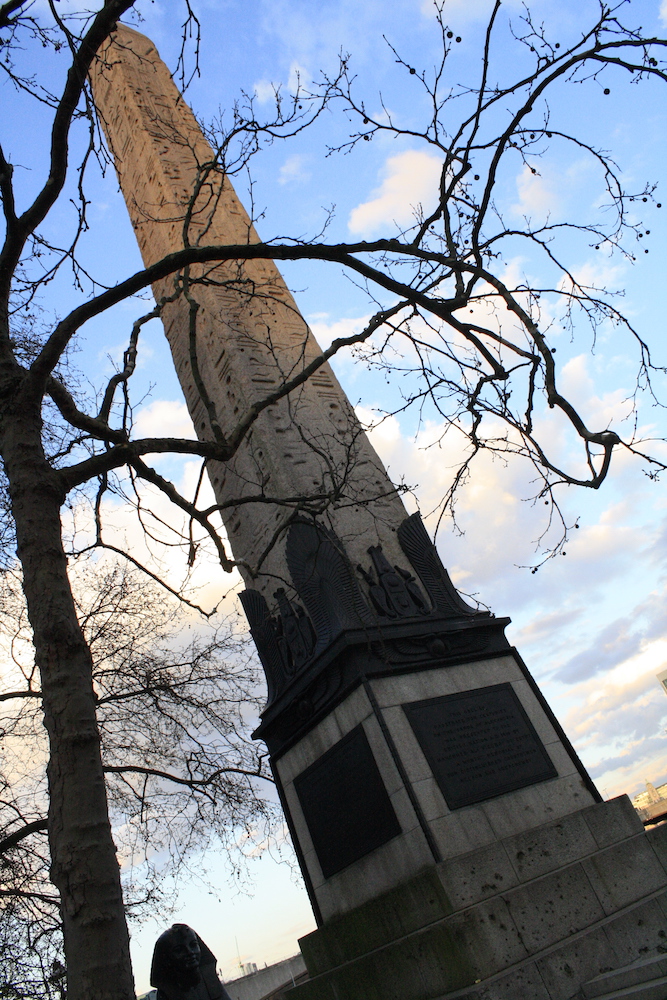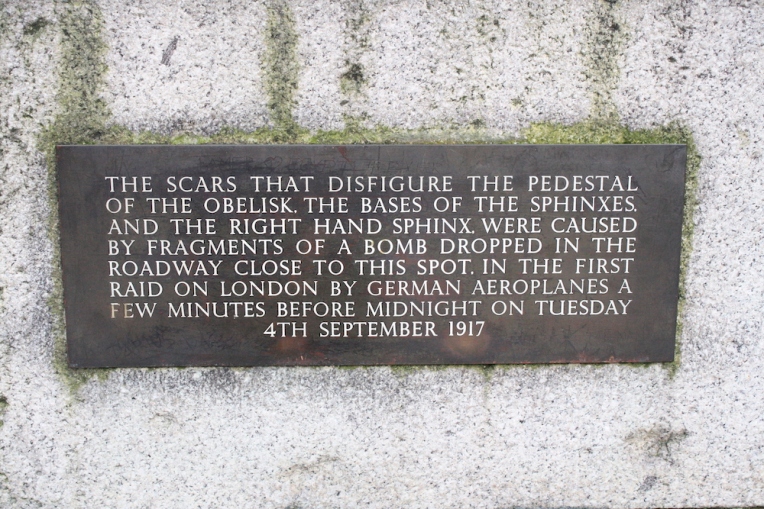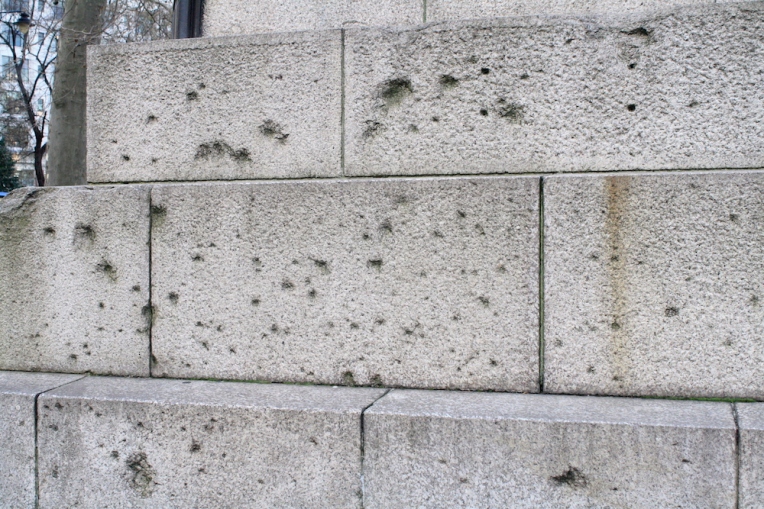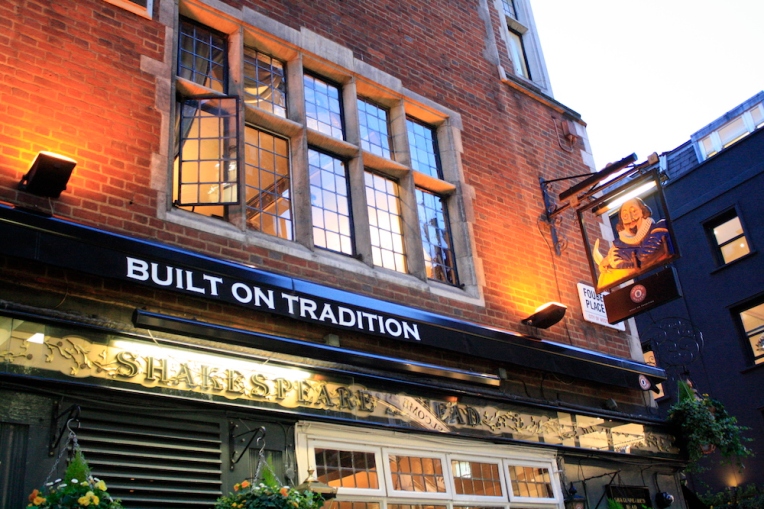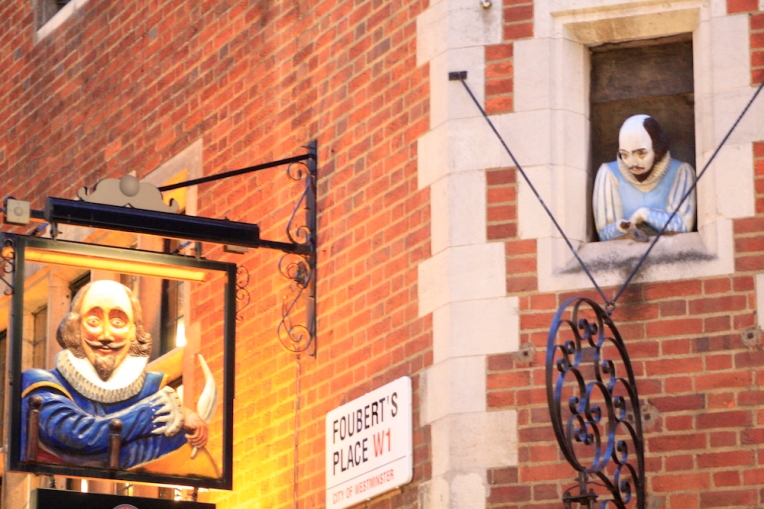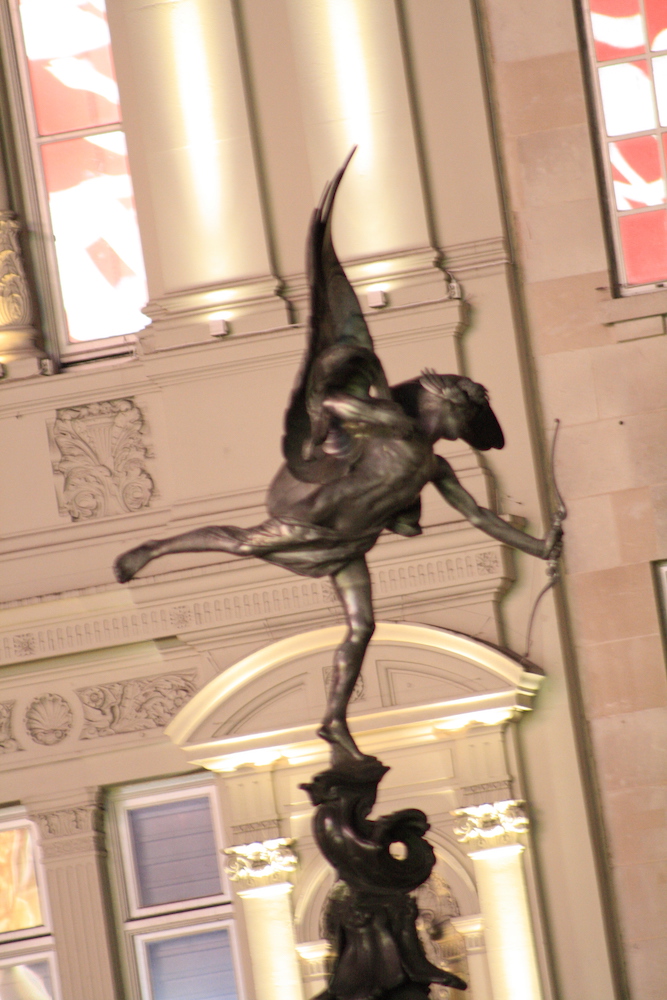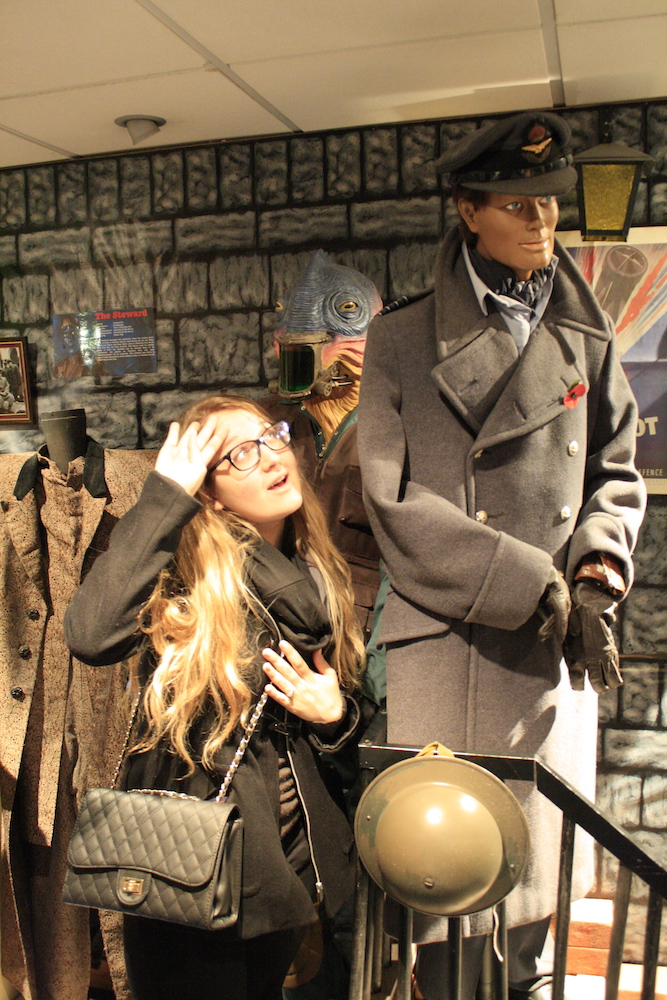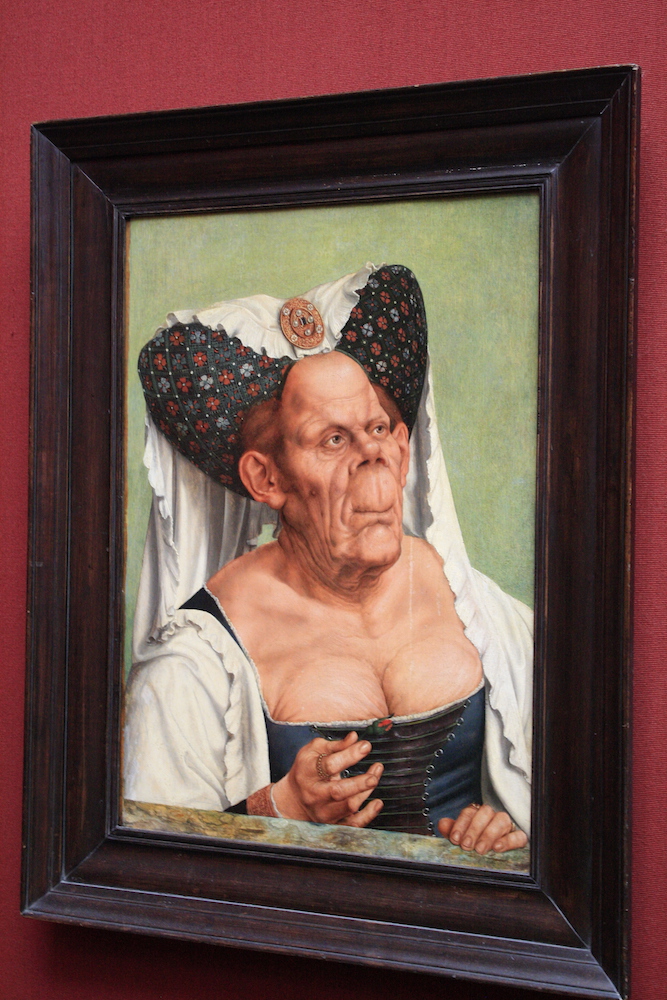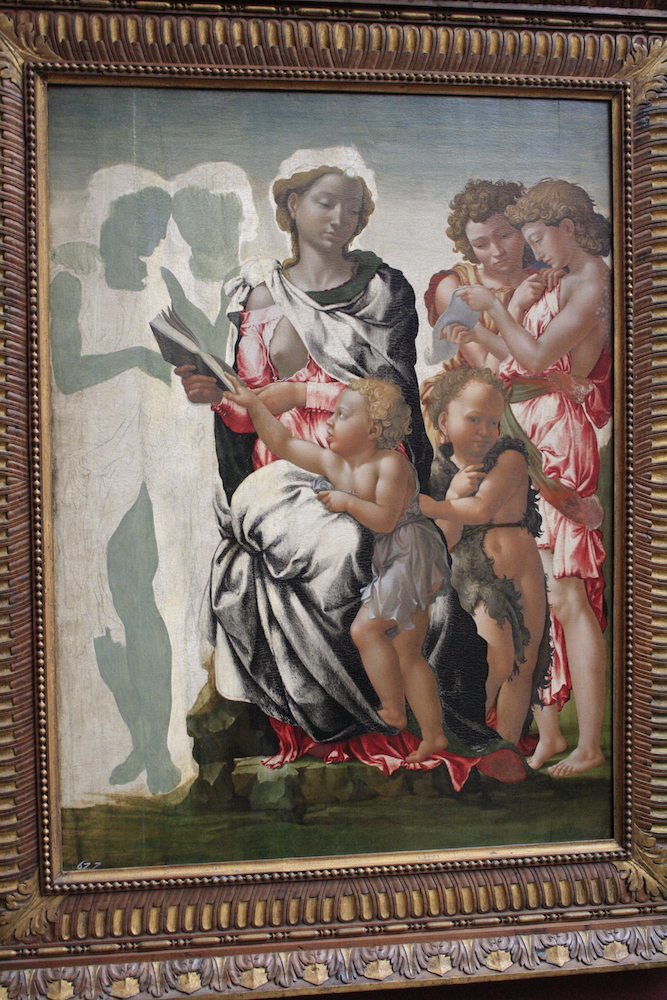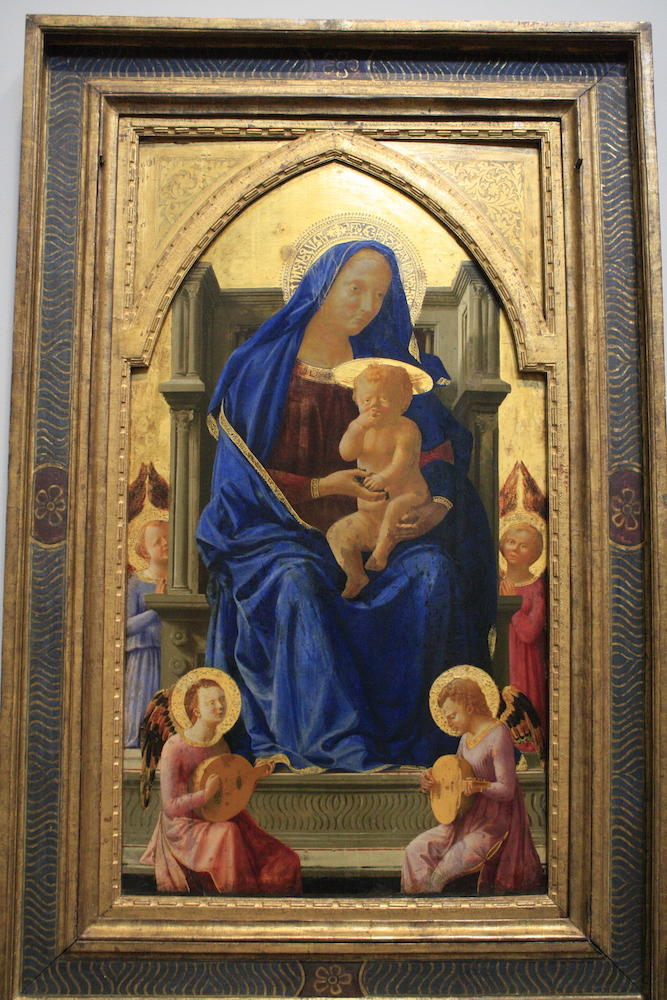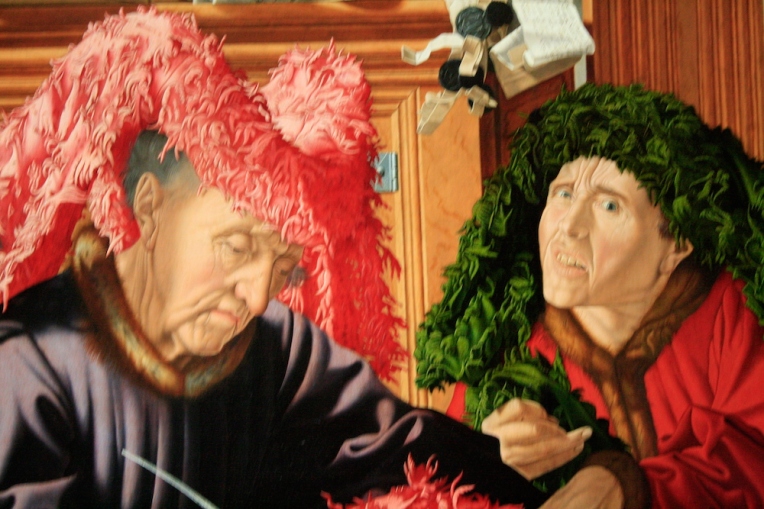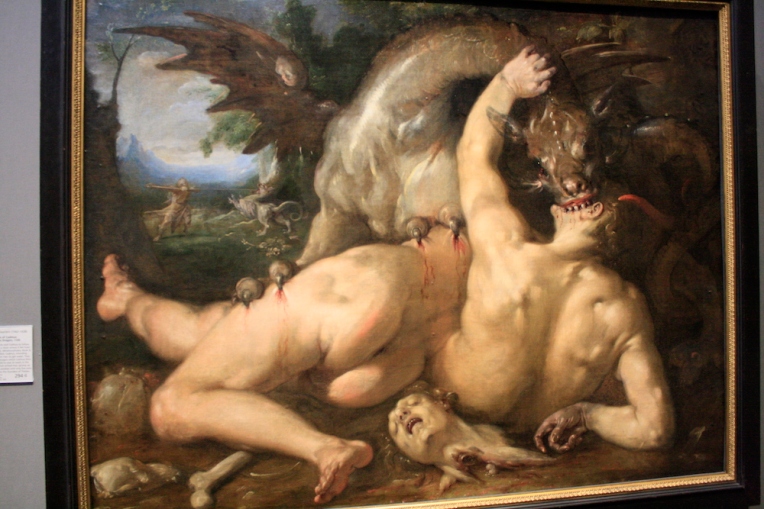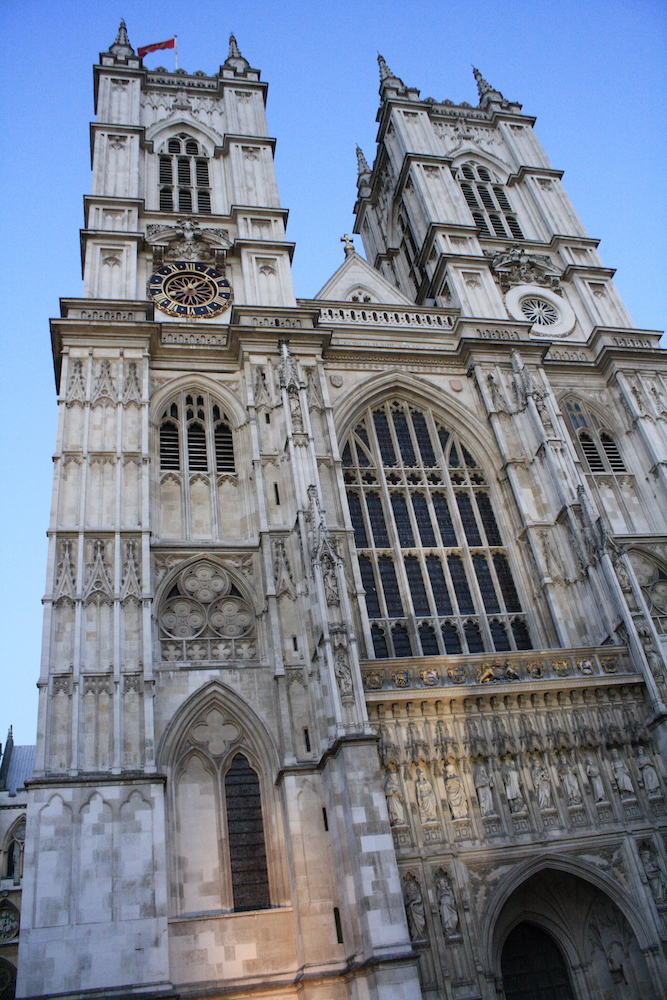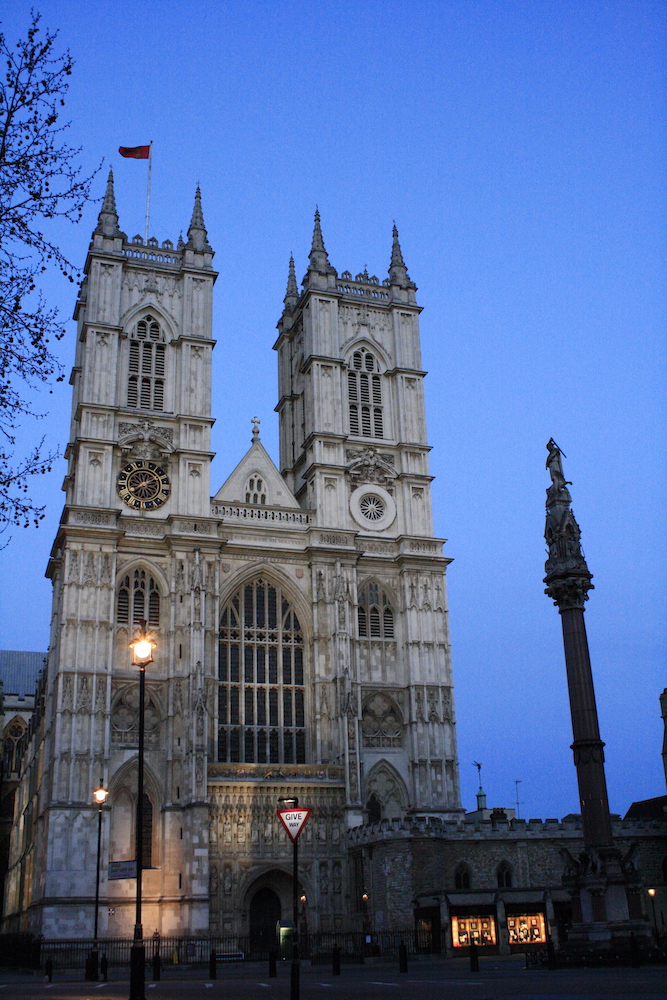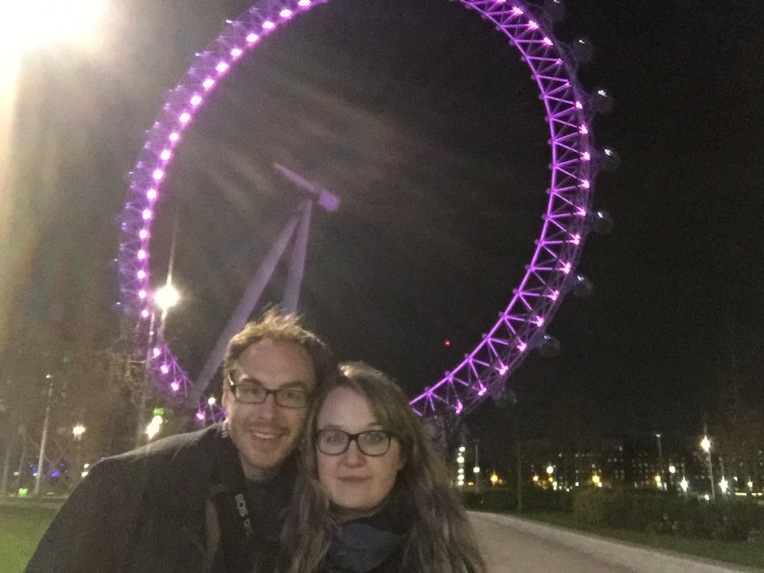Let’s see…Day 1 was the general visit of the “Must-See” areas of Paris (Sacré-Cœur, Eiffel Tower, Arc de Triomphe). Day 2 was more “Must Sees” because Paris has so many things to offer (Notre-Dame, Louvre exterior, Moulin Rouge at night). Day 3 included a visit to the Catacombs of Paris. Day 4 was spent in Versailles. Man, that’s quite a bit of touristing. But with 3 full days and 1 partial day remaining, we were finding that there’s always something to see and do in “The City of Love.”
So what did we do on Day 5? The Louvre Museum.
Day 5 – Paris – 4/11/2016
On the day we went, the Louvre was open from 9AM-6PM, and I originally thought we’d have plenty of time to walk the museum in 9 hours…I was so wrong. Our tickets into the Louvre called for us to arrive at the museum 30 minutes before it even opened, which is no big deal – we like to arrive early for things anyway. However, when we actually got to the Louvre a conundrum arrived. The Metro dropped us off right at the inverted pyramid. It had been raining off and on all night, so we were fine being inside, but, even though there was an entrance at the inverted pyramid, our tickets stated that we had to be at the other entrance. Since there was no one at the entrance to ask, we played it safe and went to the above ground entrance. The lines there were very long (made longer by the fact that some people can’t read signs), but when it came time to actually open, our line miraculously thinned out suddenly (because a huge group of people hadn’t read the sign about which line they were supposed to be in). We pretty much walked right in.
And for the first 45 minutes to an hour, we were the only people in some of the galleries. It was really, really nice.
We’ve already done a bit of history on the Louvre when we visited its exterior on day 2, but here’s a bit about the museum itself. The museum contains “nearly 35,000 objects from prehistory to the 21st century exhibited over an area of 652,300 square feet (massive). The Louvre is the world’s most visited museum, receiving more than 9.26 million visitors in 2014. It is also one of the largest.” (Wikipedia) The Louvre Palace, which was originally built as a fortress in the 12th century by Phillip II, was extended many times until 1682, when Louis XIV moved his residency to Versailles. The palace held The Royal Academy of Painting and Sculpture for the next 100 years, but in 1793 it officially opened as the Louvre Museum with an exhibition of 537 paintings (they’ve grown a bit since then).
The museum is broken down into 3 wings, and each wing has between 3 and 4 floors. There’s the Denon Wing, Sully Wing, and Richelieu Wing. We did our best to see everything, but really that’s nearly impossible. So we saw all of the recommended “must-sees,” and then tried to scope out our favorite painters and pieces. As with all of our museum visits, we take as many pictures of the pieces we find interesting as possible. It’s really nice to be able to go back, zoom in, and study these pieces. Obviously we’re not going to put every picture we took on this post, but if you click the ones that are here, a higher resolution photo will open in a new page.
So…onward I guess. We started in the Richelieu Wing with Cour Marly and Cour Puget (cour=court). These are two open courts that house several beautiful statues (you know Brittany and I with statues…). And as I said, it was a long time before we saw anyone in the area except employees…
(Unless otherwise stated, all information about museum piece comes from placards associated with the items or the official Louvre website.)
Title: Captives
Artist: Martin Van Den Bogaert, called Desjardins
Date: 1682
Info: (From the placard – translated from French.) “Bronze, once golden. From the pedestal of the statue of the Place des Victoires, these captives represent the nations defeated in the Peace of Nijmegen. Each also expresses a different feeling in the ordeal of captivity : revolt, hope, resignation, dejection. The models were executed in 1682. The bronze trophies have been added after the contract of March 9, 1685. After being preserved at the Invalides (1804-1939), they were awarded to the Louvre museum in 1960 and deposited in the Château de Sceaux from 1961 to 1992.”

Title: Winter
Artist: Attributed to Pierre I Legros
Date: unknown (Supposed artist’s life was from 1629-1714)
Info: Marble
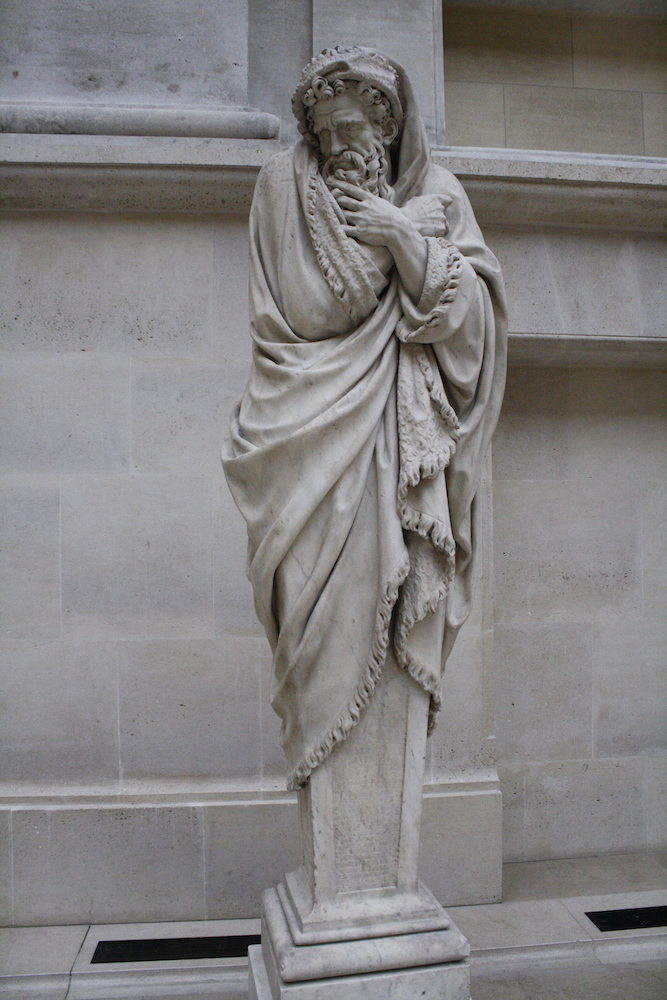
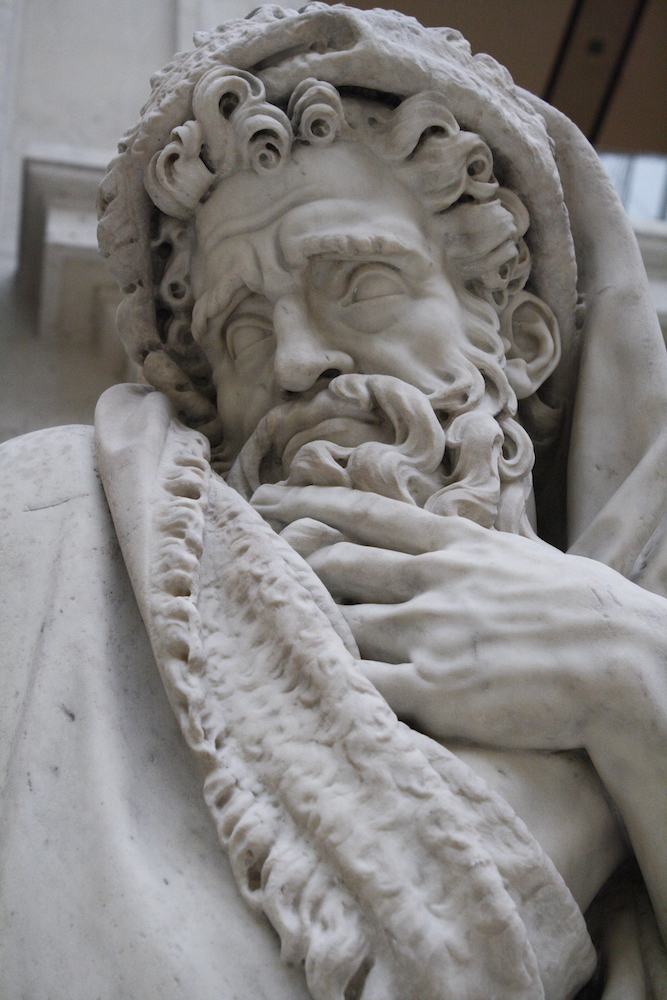
Title: Hercules fighting Achelous turned into a Serpent
Artist: François-Joseph Bosio
Date: 1824
Info: (French) Bronze. “The plaster model exhibited in the 1814 Room.
The subject draws from Ovid’s Metamorphoses: Achelous was the rival of Hercules for the love of Deianeira; during the bout, Achelous turned into a serpent but was vanquished by Hercules. Thus Hercules was beloved of Dejanira .
Later, trying to rekindle his love for her, Deianira offered Hercules a tunic impregnated with Nessus’s blood, instead of being a love potion, the tunic proved to be a burning poison.”


Title: Philopoemen
Artist: Pierre-Jean, called David D’Angers
Date: 1837
Info: Marble. “Nicknamed “the last of the Greeks” by Plutarch, this strategist organized the struggle of Hellenic cities against the Roman threat. Taken prisoner by the Romans, he was sentenced to drink hemlock .”

Title: The Hero Overpowering a Lion
Artist: Unknown.
Date: circa 721-705 BC
Info: “Façade M of the entrance court of the excavation site of Khorsabad.”

One word – Perspective…(also shown in this picture – Bull with Human Head and Wings)

This is a photo of Cour Marly to show 1) just how large the area is (and a huge chunk of the court is not shown) and 2) just how few people were here at the time.
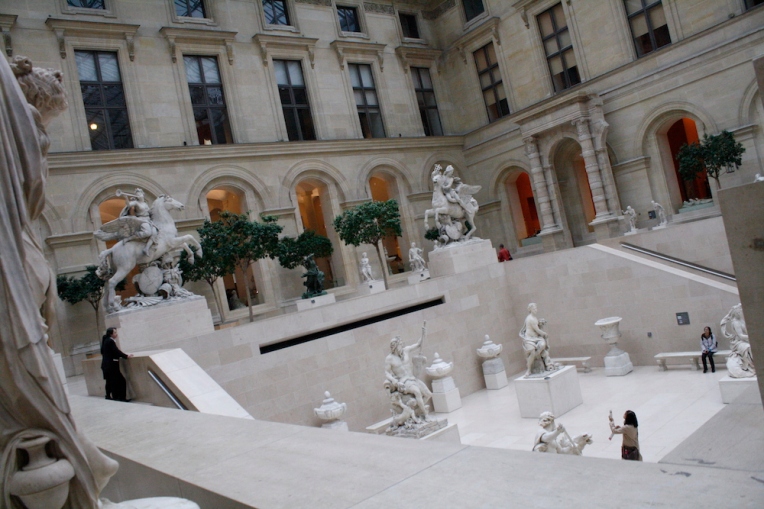
A quick side note here, as mentioned, hardly anyone was at the Louvre yet. At this point we were on the Ground Floor of the Richelieu Wing, and two girls were in the same area. Brittany and I and the group of girls walked around individually for a bit before one of the girls said, “Brittany?” Brittany had just randomly run into two people she knew…from the states…in one of the largest museums in the world. Apparently one of Brittany’s friends from Bologna was also at the museum that day too, but we never saw her. Weird but true.
Title: Tympanum decorated with a Leafy Mask
Artist: Unknown
Date: end of the 13th century, beginning of the 14th century
Info: “Possibly from the Abbey of Saint-Denis. Artwork used by Alexandre Lenoir in the decor of a fictional mausoleum of Queen Blanche of Castile, placed in 1804 in the introductory hall of the Museum of French Monuments . Around the arc of the eardrum can be glimpsed the remains of the inscription engraved on it: Madam Queen Blanche, mother of Saint Louis.”

Title: Tomb of Philippe Pot (1428-1493) , Grand Senechal of Burgundy
Artist: Unknown.
Date: 1493
Info: Limestone. “Represented laid on a bed in knightly attire, with a lion lying at his feet; the catafalque is supported by eight pallbearers clad in hooded black habits. From the chapel of St John the Baptist in the abbey of Cîteaux.”



Title: La Mort Saint-Innocent
Artist: Unknown.
Date: around 1530
Info: Alabaster. In the Saints-Innocents cemetery since 1530 (where many of the bones in the Catacombs of Paris were). When the cemetery was closed in 1786, this sculpture was moved to Saint-Gervais church, then to Notre-Dame, where the arm was restored by Deseine. Then, to the French Museum of Monuments. The shield reads: “Il n’est vivant tant soit plein d’art, Ne de force pour resistance, Que je ne frappe de mon dard, Pour bailler aux vers leur pitance, Priez Dieu pour les trepasses.” (I spent several hours today trying to translate this, but it never made any sense…why 16th century French would make sense to me is something I never asked myself. Brittany even emailed it to a French friend of hers, and she couldn’t quite get it to make sense. But I finally…finally found a translation online from a book published in 1825, Paris: From the Earliest Period to the Present Day; Volume 2 by William Walton. Thank you, Project Gutenburg!)
“There is none living, however artful or strong to resist, that I do not strike with my dart, to give to the worms their share. Pray to God for the dead.”

Title: Ummm…Darth Vader’s Helmet…very nice…
There was a special exhibit called “Founding Myths: From Hercules to Darth Vader” going on while we were there.

Also in the exhibit was this original storyboard…

The Louvre Palace (and subsequently the Louvre Museum) is a giant maze. This place is floor to ceiling art, and floor to ceiling go on and on and on. Even with a map we were struggling to figure out just where we were sometimes. Versailles is beautiful, and its gardens are unmatched, but as far as palaces go, I think the Louvre would have the edge. What it would have been like to see them both in their prime…
At some point we ended up in the Sully Wing with the Ancient Egyptian artifacts.
Title: Mummies of Cats
Artist: None.
Date: Not Listed.
Info: Seriously just cat mummies…
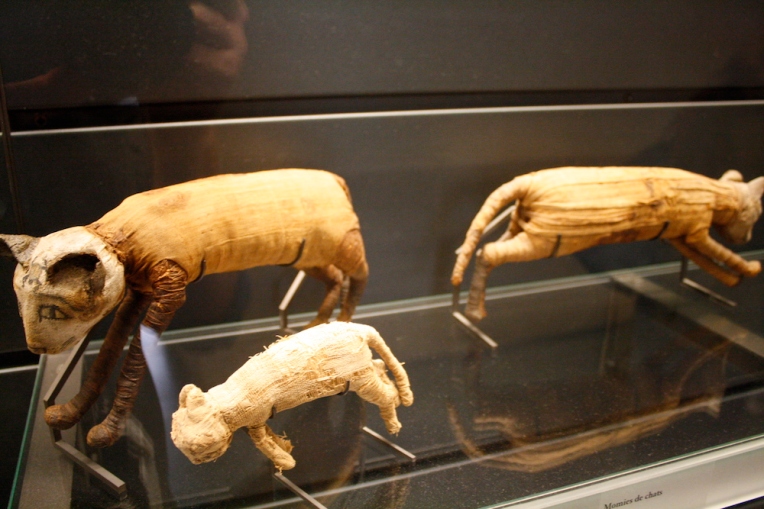
Title: Stele dedicated by King Amasis to the Apis bull that died during his reign
Artist: Unknown.
Date: 26th Dynasty (circa 1069-30 BC)
Info: Limestone. “This stele is an official monument, dedicated by King Amasis to a sacred Apis bull that died during his reign. It is very thick, and must have been incorporated into the stonework that blocked the entrance to the bull’s tomb at the Serapeum of Memphis. At the top of the stele, under the hieroglyph for sky and a winged sun disk, King Amasis kneels before the Apis bull, separated from it by an offering table covered with slices of bread. The text records the major dates in the life of the sacred animal.”

Title: Mummy of a Man
Artist: None.
Date: Ptolemaic Period (305-30 BC)
Info: Linen fabric coated and painted. “This extremely well preserved mummy is that of a man who lived during the Ptolemaic Period. According to the results of an X-ray analysis, this mummy is that of an adult man. His name, written hastily, can be read as either Pachery or Nenu; the interpretation is still uncertain. According to the customs of the time, the body of the deceased was carefully wrapped in strips of linen; the design formed by these strips, notably around the face, was often extremely sophisticated. The mummy is covered with a cartonnage consisting of several elements: a mask covering the head, a wide collar over the chest, an apron across the legs, and finally, a casing over the feet.”

Title: Relief from the Temple of Montu at Tod
Artist: Unknown.
Date: 11th Century Dynasty
Info: Limestone. “The late 11th Dynasty witnessed the revival, after more than two centuries, of the difficult art of bas-relief sculpture. It can be admired on vestiges from one of the earliest stages of construction of the temple at Tod. This bas-relief and the blocks that are exhibited beside it were found buried beneath the foundation sand of the later sanctuary, which explains why they escaped the fate of most limestone works: disappearing into the lime kilns.”

Now, we know the description of this piece that is listed above is important, but what it fails to describe is that this is like the ultimate poster of the upcoming X-Men Apocalypse movie. I mean, come on, an ancient Egyptian relief with what’s clearly the symbol for the X-Men…
Title: Six Sphinxes
Artist: Unknown.
Date: possibly 13th Dynasty (1803-1649 BC)
Info: Limestone. “Several hundred sphinxes similar to this one once lined the processional way to the Serapis Temple (the Serapeum in Saqqara), which no longer exists. This sanctuary, a major pilgrimage site in late antiquity, was once very famous. All that remains today is its underground structures: the necropolis of the Apis bulls begun during the reign of Ramesses II. Archaeologist Auguste Mariette determined the location of the temple as the walkway was cleared, one sphinx at a time.”
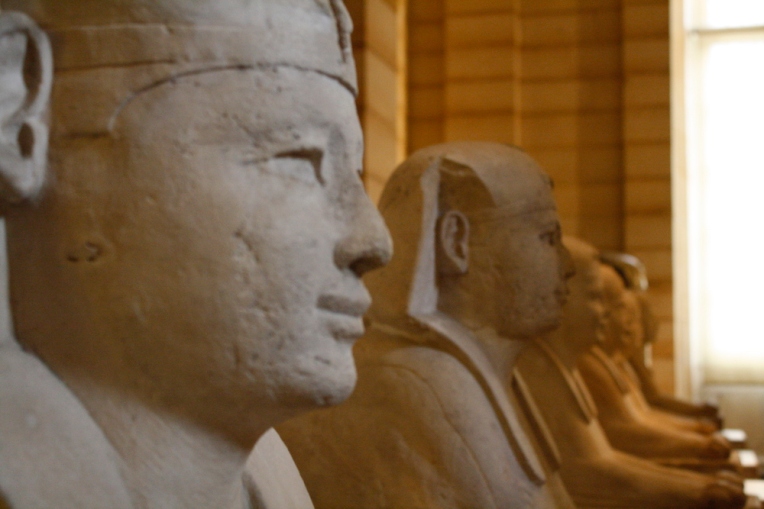
Title: Eyes Inlaid in Wooden Coffin
Artist: Unknown.
Date: end 18th Dynasty (1543-1292 BC)
Info: None listed.

Title: Athena known as The Pallas of Velletri
Artist: Cresilas (Original)
Date: 430 BC (Original)
Info: Marble. “This huge statue of Athena, found in Velletri in the eighteenth century, is a copy of a bronze effigy, now lost, known from Roman copies and fragments of antique casts, found in Baia, near Naples. The original, dating from about 430 BC, is generally attributed to Cresilas, a Cretan sculptor who also produced a portrait of Pericles, a copy of which is in the British Museum. The hero’s oval face and sharply defined features are strikingly similar to those of the goddess.”

Title: Athena (called Peaceable or Mattei Athena)
Artist: Unknown.
Date: late 2nd century BC of 2nd century AD
Info: Marble. “The Athena Mattei is exceptional in that it is a Roman replica of a Greek statue that has also survived. The figure is a copy of the Piraeus Athena, a fourth-century BC bronze statue, created by Cephisodotus or Euphranor, discovered in 1959. The erstwhile goddess of war – seen here in a more benevolent attitude – wears a helmet and, across her chest, the aegis (the skin of the goat of Amaltheia), bordered with snakes and adorned with the head of the gorgon Medusa.
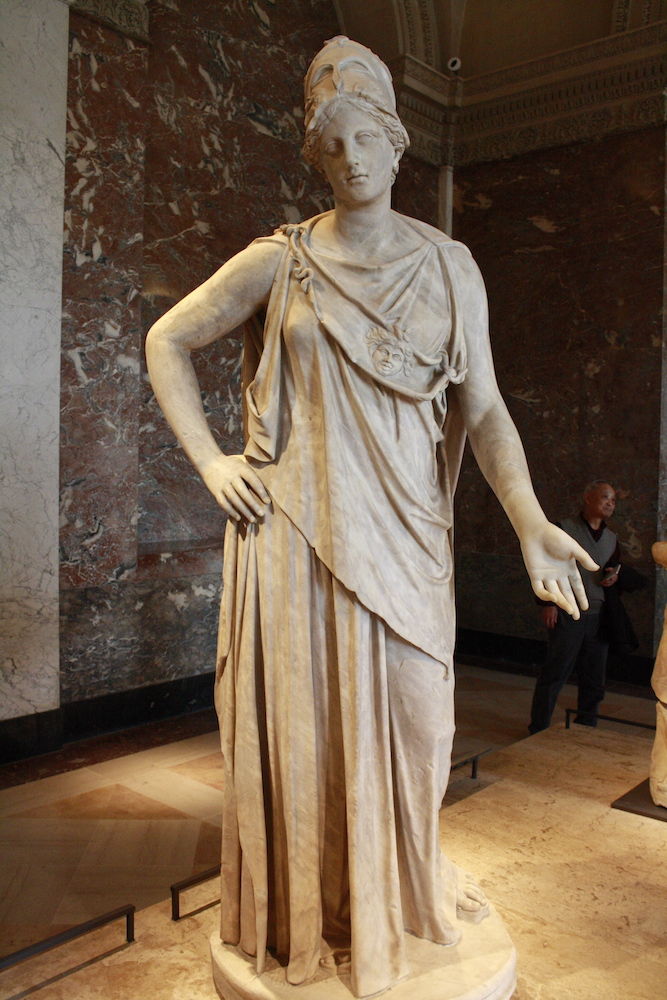
Title: Crouching Aphrodite (called Venus of Vienna)
Artist: Unknown.
Date: 1st or 2nd century CE
Info: Marble. “Aphrodite, the Venus of the Romans, is seized upon while bathing, and seems surprised. The small hand preserved on her back belonged to Eros, the god of Love, who plays with the goddess, his mother. The pattern is known because of many antique replicas particularly appropriate for the decor of the public and private baths. It is inspired by a crouching Aphrodite Greek, now lost.”

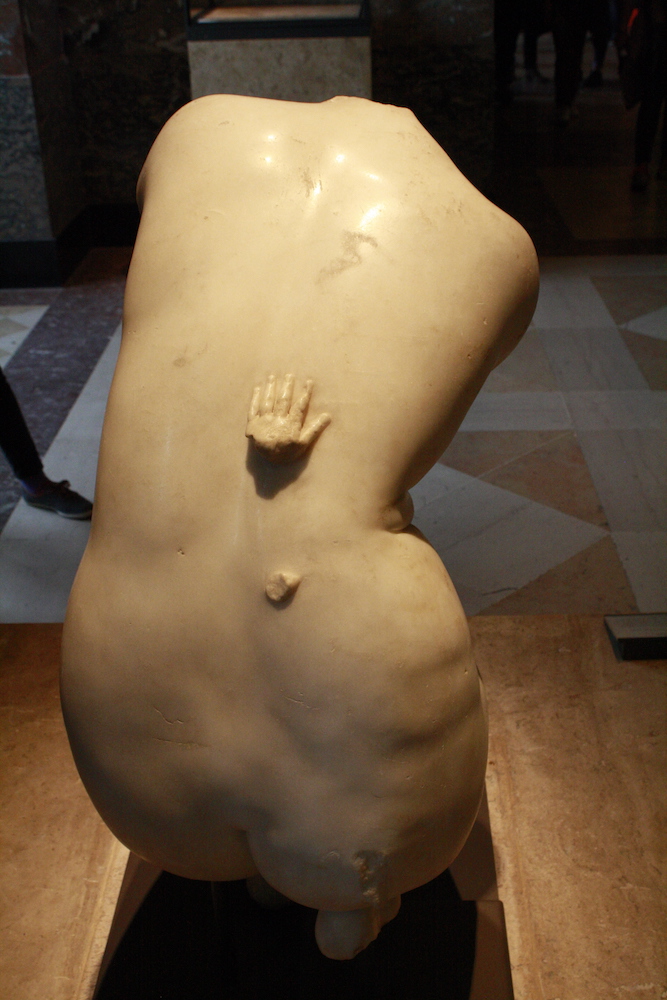
Title: Aphrodite, known as the Venus de Milo
Artist: Unknown.
Date: around 100 BC
Info: Marble. “This graceful statue of a goddess has intrigued and fascinated since its discovery on the island of Melos in 1820. Is it Aphrodite, who was often portrayed half-naked, or the sea goddess Amphitrite, who was venerated on Milo? The statue reflects sculptural research during the late Hellenistic Period: classical in essence, with innovatory features such as the spiral composition, the positioning in space, and the fall of the drapery over the hips. The goddess originally wore metal jewelry — bracelet, earrings, and headband — of which only the fixation holes remain. The arms were never found.”
Honestly, Brittany and I both agreed on this, Venus de Milo is an interesting statue somewhat shrouded in mystery, but it pales in comparison to some of the other sculptures we’ve seen…namely Michelangelo’s David.

Title: Old Centaur teased by Eros
Artist: Unknown. (Possibly Aristeas and Papias of Aphrodisias)
Date: 1st–2nd centuries AD
Info: Marble. “Roman copy of a Greek original of the 2nd century BC. Found in Rome in the 17th century, belonged to the Borghese collections. A grey-black marble statue of the same type was found in the Villa Adriana in Tivoli together with a grey-black marble Young Centaur laughing at Eros’s wounds. The pair, now shown in the Capitoline Museums, bear the signature of Aristeas and Papias of Aphrodisias, a city in Asia Minor. It can surmised that the Louvre statue was an element from a pair as well. The original right arm of the centaur is pulled tautly back showing that he has his hands bound tightly behind his back, and grimaces in pain and sorrow as an amorino pulls the centaur’s head back at an abrupt angle.” (Wikipedia)
We nicknamed this pair Josh and Dylan, since we had established at the Uffitzi Museum that Josh has been a centaur in a previous life.
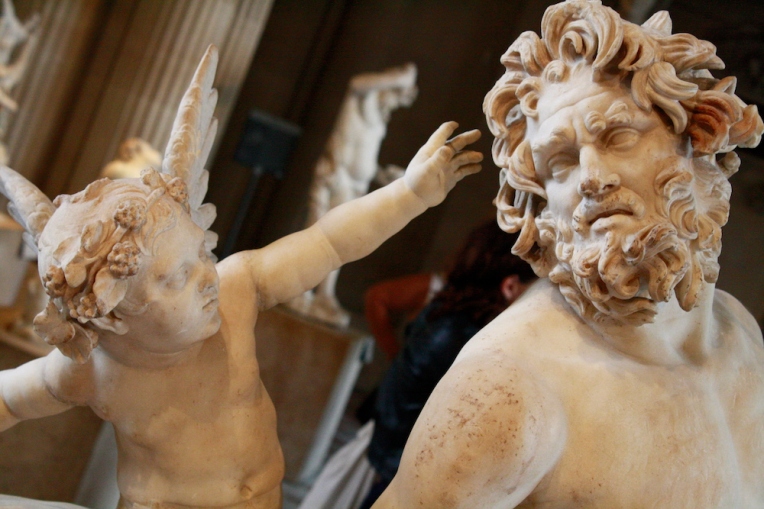

We then entered the Denon Wing (although we’d probably wandered in and out of it already without knowing).
Title: The emperor Lucius Verus
Artist: Unknown.
Date: between 180 and 183 AD
Info: Marble. “This is a colossal head of Lucius Verus, co-emperor with Marcus Aurelius from AD 161-169. Lucius’s features are familiar from a number of other portraits. The monumental dimensions of this effigy, which exemplifies the transition from the sensitive works of the Antonian period to the more extravagant baroque style, served to glorify the ruler after his death. The prince’s features are recognizable from many other portraits – notably his luxuriant hair and beard, portrayed here with deeply sculpted curls.”
We called this one Chris Pratt…
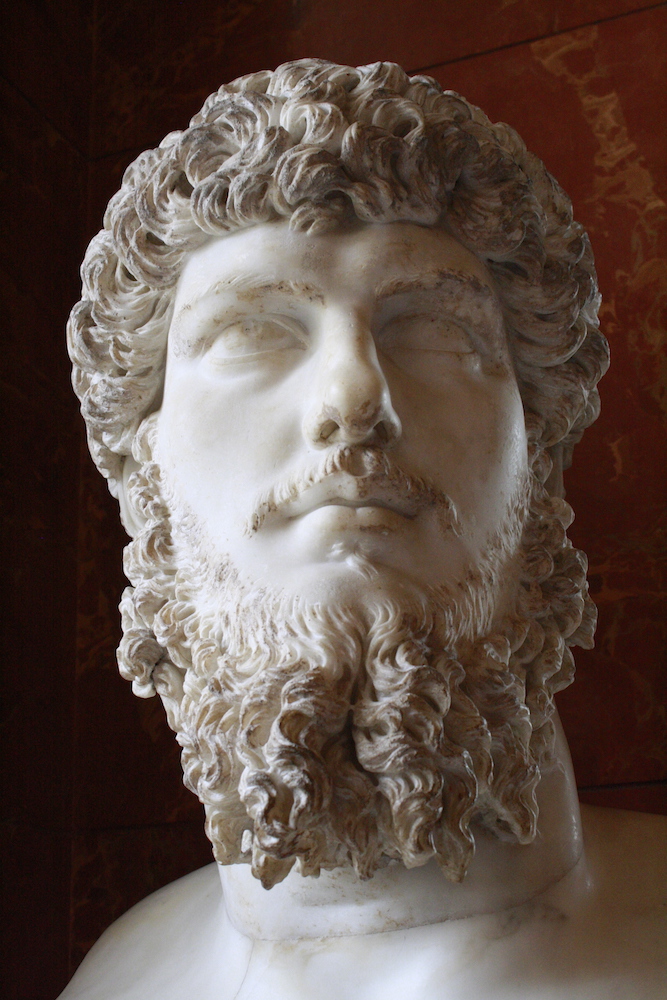
Title: The Tiber
Artist: Unknown.
Date: early 2nd century AD
Info: Marble. “This statue, very much admired since its discovery in 1512, is a personification the Roman river Tiber. It decorated a temple dedicated to Isis and Sarapis, and was the pendant to a similar statue depicting the Nile.
The work explores the river’s link to Roman mythology, and its fertility – the river-god is accompanied by Romulus and Remus, the city’s legendary twin founders, while the reliefs on its base illustrate their mythic exploits and the river’s beneficial effects.”

(I thought this was a fun and interesting angle…)

Title: Melpomene: Muse of Tragedy
Artist: Unknown.
Date: 1st century BC-1st century AD
Info: Marble. As with five other statues of the same size, Melpomene was discovered at the Champ de Mars. This is probably the group of nine muses that decorated the theater or the portico of Pompey, the first building of stone spectacle in Rome.

Title: The Winged Victory of Samothrace
Artist: Unknown. (Possibly Pythokritos of Lindos)
Date: circa 190 BC
Info: Marble. “The winged goddess of Victory standing on the prow of a ship overlooked the Sanctuary of the Great Gods on the island of Samothrace. This monument was probably an ex-voto offered by the people of Rhodes in commemoration of a naval victory in the early second century BC. The theatrical stance, vigorous movement, and billowing drapery of this Hellenistic sculpture are combined with references to the Classical period-prefiguring the baroque aestheticism of the Pergamene sculptors.”

This is my favorite piece at the Louvre…
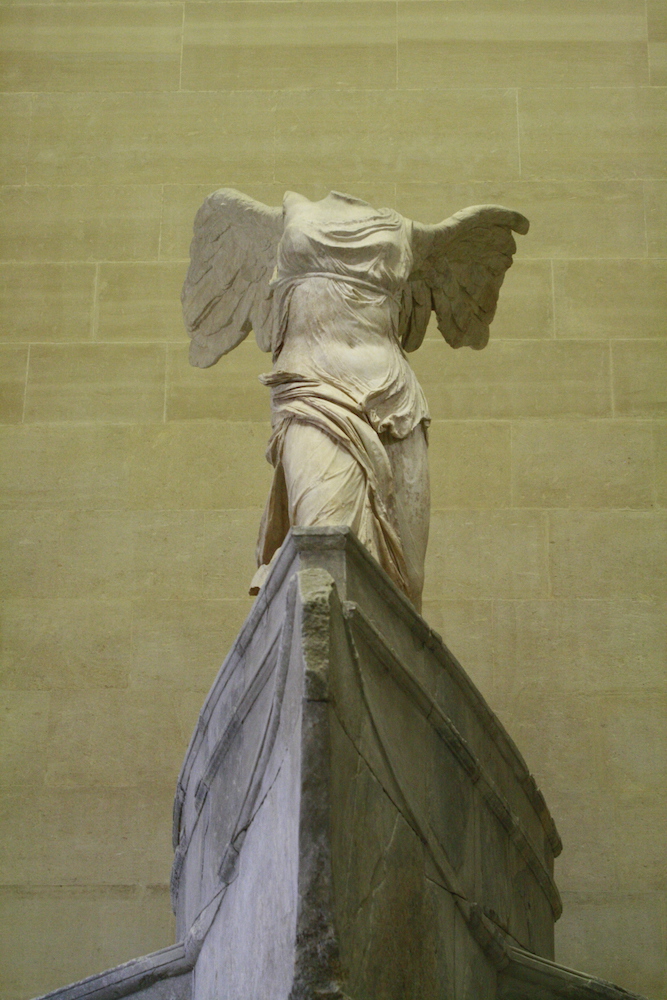
“A presentation mixing grandeur and theatricality: This exceptional monument was unearthed in 1863 on the small island of Samothrace in the northwest Aegean. It was discovered by Charles Champoiseau, French Vice-Consul to Adrianople (Turkey). The goddess of Victory (Nike, in Greek) is shown in the form of a winged woman standing on the prow of a ship, braced against the strong wind blowing through her garments. With her right hand cupped around her mouth, she announced the event she was dedicated to commemorate. The colossal work was placed in a rock niche that had been dug into a hill; it overlooked the theater of the Sanctuary of the Great Gods. This niche may also have contained a pool filled with water in which the ship appeared to float. Given its placement, the work was meant to be viewed from the front left-hand side; this explains the disparity in sculpting technique, the right side of the body being much less detailed. The highly theatrical presentation-combined with the goddess’s monumentality, wide wingspan, and the vigor of her forward-thrusting body-reinforces the reality of the scene.”

“A commemorative Rhodian monument: The sanctuary at Samothrace was consecrated to the Cabeiri, gods of fertility whose help was invoked to protect seafarers and to grant victory in war. The offering of a statue of Nike perched on a ship was a religious act in honor of these gods. It has also been suggested that this monument was dedicated by the Rhodians in commemoration of a specific naval victory. The type of ship depicted and the gray marble used for the prow and base of the statue both suggest that this is indeed a Rhodian creation. If it is associated with a major Rhodian naval victory, the work can be dated to the second century BC-it would have been erected in honor of the battle of Myonnisos, or perhaps the Rhodian victory at Side in 190 BC against the fleet of Antiochus III of Syria.”

“A Hellenistic work steeped in tradition: The Winged Victory of Samothrace is one of the masterpieces of Hellenistic sculpture. The figure creates a spiraling effect in a composition that opens out in various directions. This is achieved by the oblique angles of the wings and the placement of the left leg, and emphasized by the clothing blowing between the goddess’s legs. The nude female body is revealed by the transparency of the wet drapery, much in the manner of classical works from the fifth century BC, while the cord worn just beneath the breasts recalls a clothing style that was popular beginning in the fourth century. In the treatment of the tunic-sometimes brushing against the body, sometimes billowing in the wind-the sculptor has been remarkably skillful in creating visual effects. The decorative richness, sense of volume, and intensity of movement are characteristic of a Rhodian style that prefigures the baroque creations of the Pergamene school (180-160 BC).”

Title: The Virgin of the Rocks
Artist: Leonardo da Vinci
Date: 1483-1486
Info: Oil on wood panel. “Leonardo’s emblematic and complexly symbolic The Virgin of the Rocks celebrates the mystery of Incarnation in portrayals of the Virgin Mary, Christ and Saint John the Baptist. For the first time, these holy figures, bathed in a gentle light, are set in rocky landscape. The many contemporary copies of the picture attest to the immense popularity of this new vision of the theme.”
We saw the other version of this painting at the National Gallery in London. This version is generally considered to be the older of the two.

Title: Mona Lisa (Portrait of Lisa Gherardini, wife of Francesco del Giocondo)
Artist: Leonardo da Vinci
Date: circa 1503-1506 (possibly continuing to work on it until as late as 1517)
Info: Oil on panel. “This portrait was doubtless started in Florence around 1503. It is thought to be of Lisa Gherardini, wife of a Florentine cloth merchant named Francesco del Giocondo – hence the alternative title, La Gioconda. However, Leonardo seems to have taken the completed portrait to France rather than giving it to the person who commissioned it. After his death, the painting entered François I’s collection.
The history of the Mona Lisa is shrouded in mystery. Among the aspects which remain unclear are the exact identity of the sitter, who commissioned the portrait, how long Leonardo worked on the painting, how long he kept it, and how it came to be in the French royal collection.
The portrait may have been painted to mark one of two events – either when Francesco del Giocondo and his wife bought their own house in 1503, or when their second son, Andrea, was born in December 1502 after the death of a daughter in 1499. The delicate dark veil that covers Mona Lisa’s hair is sometimes considered a mourning veil. In fact, such veils were commonly worn as a mark of virtue. Her clothing is unremarkable. Neither the yellow sleeves of her gown, nor her pleated gown, nor the scarf delicately draped round her shoulders are signs of aristocratic status.”
This is about as close as we got to the painting. It is, by far, the most popular piece at the Louvre, and everyone wants to see it.

Luckily we didn’t need to get to close to zoom in with the camera. The painting is beautiful, but you don’t really get a good opportunity to just look at it, so we went to look at something else…
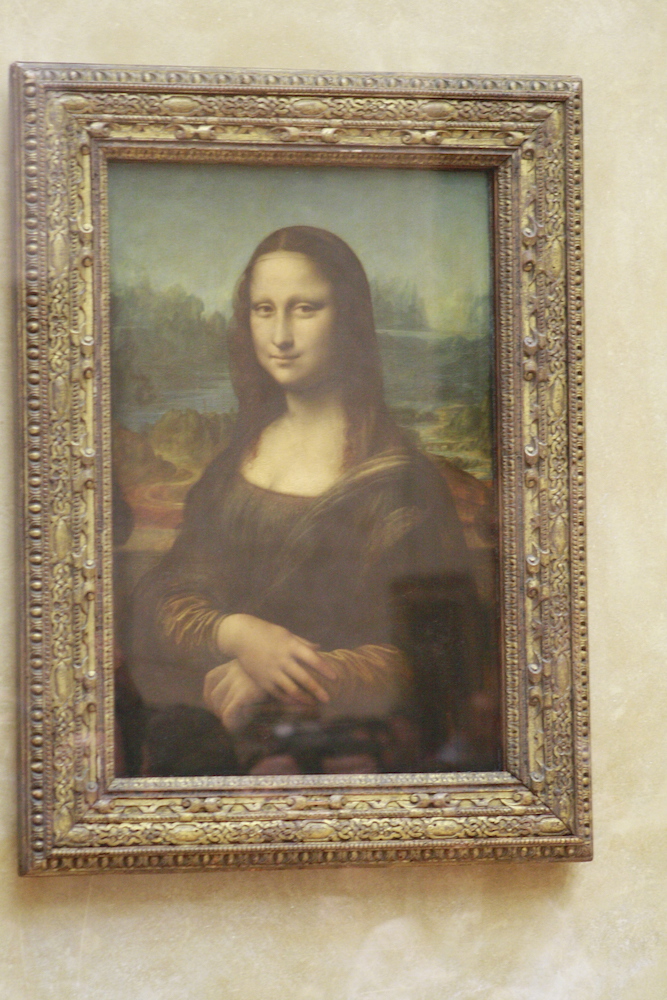
Title: Ceres (or Abundance)
Artist: Giulio Romano (a pupil of Raphael)
Date: around 1516
Info: Oil on wood. “The work was probably carried out in 1516 by order of Cardinal Bernardo Dovizi whose name means “Abundance” and six ears of corn were on his coat of arms. The figure is directly inspired by an antique Venus Genitrix that adorned the Marmi Gallery, a room of the Ducal Palace of Mantua decorated by Giulio Romano.” (Wikipedia)
I really liked this painting because it seemed out of time. It looks like it should be an Art Deco piece (you’re welcome, momma) from the 1920s, 30s, or 40s rather than something painted in 1516.

Title: The Intervention of the Sabine Women
Artist: Jacques-Louis David
Date: 1799
Info: “After the abduction of the Sabine women by the neighboring Romans, the Sabines attempted to get them back – David depicts this episode here. The Sabine women are intervening to stop the bloodshed. Hersilia is throwing herself between her husband, the king of Rome, and her father, the king of the Sabines. David is using the subject to advocate the reconciliation of the French people after the Revolution. His increasingly simple style is inspired by Ancient Greece.
David’s painting depicts a legendary episode from Rome’s beginnings in the 8th century BC. After the Sabine women had been abducted by the neighboring Romans (the scene Poussin depicted in his masterpiece The Rape of the Sabine Women, Louvre), the Sabines attempted to get them back. David shows the Sabine women intervening to stop the battle raging beneath the ramparts of the Capitol in Rome. The painting is a masterful summary of the whole episode. Hersilia is leaping between her father Tatius, the king of the Sabines, on the left, and her husband Romulus, the king of Rome, on the right. A woman is pointing at her children; another has thrown herself at a warrior’s feet. The picture also evokes the happy consequences of their intervention. The horseman on the right is putting his sword back into its sheath while, further away, hands and helmets are raised in gestures of peace. Unlike in David’s previous paintings (The Oath of the Horatii, Brutus, Louvre), women play the crucial role here.”

We took several detail pictures of this piece (I’ve only included one here) because there’s SO much detail to look at. Plus, after going to Rome (Roma) and living in Italy for a while, we understand a lot of the painting’s references now.

Title: Aurora and Cephalus
Artist: Baron Pierre-Narcisse Guérin
Date: 1810
Info: Oil on canvas. “This ethereal night, reminiscent of The Sleep of Endymion by Girodet (1791) , was involved in the ‘graceful’ last phase of neoclassicism.” Aurora is the Roman goddess of Dawn. Eos (the Greek version of Aurora) kidnapped Cephalus when he was hunting. The resistant Cephalus and Eos became lovers. (Wikipedia)

Title: Korwar reliquary (container for relics)
Artist: Unknown.
Date: late 18th century
Info: Wood and human skull. “Ancestor figure protecting the household.” Indonesian.

Title: Easter Island Moai
Artist: Unknown.
Date: between 1250 and 1500 CE
Info: Tuff (rock made of volcanic ash). “Monolithic human figures carved by the Rapa Nui people on Easter Island in eastern Polynesia.” (Wikipedia)

Our wanderings led us back near the stairs leading to The Winged Victory, so I grabbed a shot of the statue “in its natural habitat.” Though, there is another flight of steps leading further down that isn’t pictured.

Title: Psyche Revived by Cupid’s Kiss
Artist: Antonio Canova
Date: 1777
Info: Marble. “This winged young man who has just landed on a rock where a girl lies unconscious, is the god Eros – Cupid in Latin – and can be recognized by his wings and his quiver filled with arrows. The girl’s name is Psyche. Cupid’s mother Venus, goddess of Beauty, demanded that Psyche bring back a flask from the Underworld, strictly forbidding her to open it.
But Psyche’s curiosity got the better of her; and no sooner had she had breathed in the terrible fumes than she fell into a deep, deathlike sleep. Seeing her lying motionless, Cupid rushed to her and touched her gently with the tip of his arrow, to make sure she was not dead. This is the moment caught by the sculptor: Cupid lifts his beloved Psyche in a tender embrace, his face close to hers. Psyche lets herself sink slowly backwards, languorously taking her lover’s head between her hands.
Canova took his inspiration from a legend recounted by Latin author Apuleius in the Metamorphoses At the close of the tale the gods decide in council to grant Cupid Psyche’s hand in marriage, according her immortality and making her the goddess of the Soul.”

Title: The Rebellious Slave
Artist: Michelangelo Buonarroti
Date: 1513
Info: Marble. “The two chained slaves express entirely different emotions. The one known as the Dying Slave is superbly young and handsome, and apparently in a deep (perhaps eternal) sleep. The other, called the Rebellious Slave, is a coarser figure whose whole body seems engaged in a violent struggle. Michelangelo intended both statues for the splendid funerary monument originally planned for and by Pope Julius II — a project which was repeatedly modified during forty years of successive programs.” (continued below)

Title: The Dying Slave
Artist: Michelangelo Buonarroti
Date: 1513
Info: Marble. “The iconographical theme is something of a mystery; there are few clues, beyond the figure of a monkey which is roughed out beside the dying slave. Do these captive figures symbolize the subjugated provinces? Or the Arts, reduced to slavery by the pontiff’s death? Perhaps they have a role to play in his eternal triumph? Should they be interpreted as enslaved passions, or (in accordance with the Platonic theme which inspired Michelangelo) do they represent the human soul, burdened by the body? An extraordinary force emanates from these tormented bodies — whose state of incompletion reinforces the impression of power.”
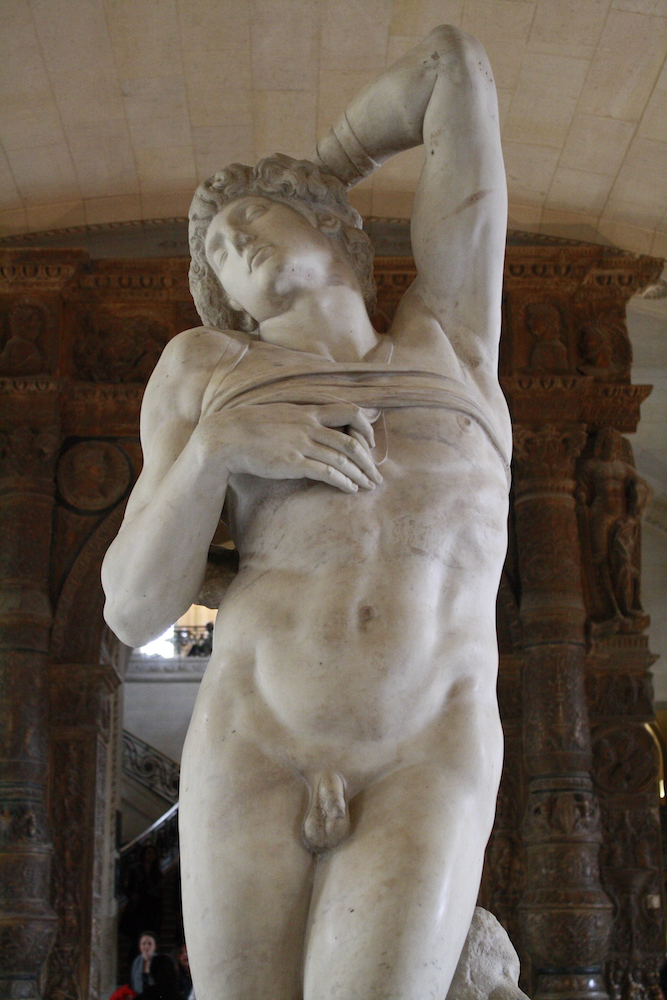
A view of the exterior of the Louvre Palace from underneath the glass Pyramide du Louvre (Louvre Pyramid). It is “a large glass and metal pyramid designed by Chinese American architect I.M. Pei, surrounded by three smaller pyramids, in the main courtyard of the Louvre Palace. The large pyramid serves as the main entrance to the Louvre Museum. Completed in 1989. It contains 603 rhombus-shaped and 70 triangular glass segments.” (Wikipedia)

Title: Fuseau Vase
Artist: Sèvres Manufactory
Date: 1810
Info: From the area of the Louvre titled Apartments of Napoleon III. “On the baptism of his son, King of Rome, on 10 June 1811, Napoleon offered the infant’s godmother – his own mother, Madame Mère – this spectacular porcelain fuseau vase. The tortoiseshell ground provides a sumptuous setting for a portrait of Napoleon crossing the Alps, after Jacques-Louis David’s famous painting. The vase is typical of the designs of Alexandre Brongniart, director of the Sèvres Manufactory, who saw in porcelain a way of giving great history painting imperishable form.”
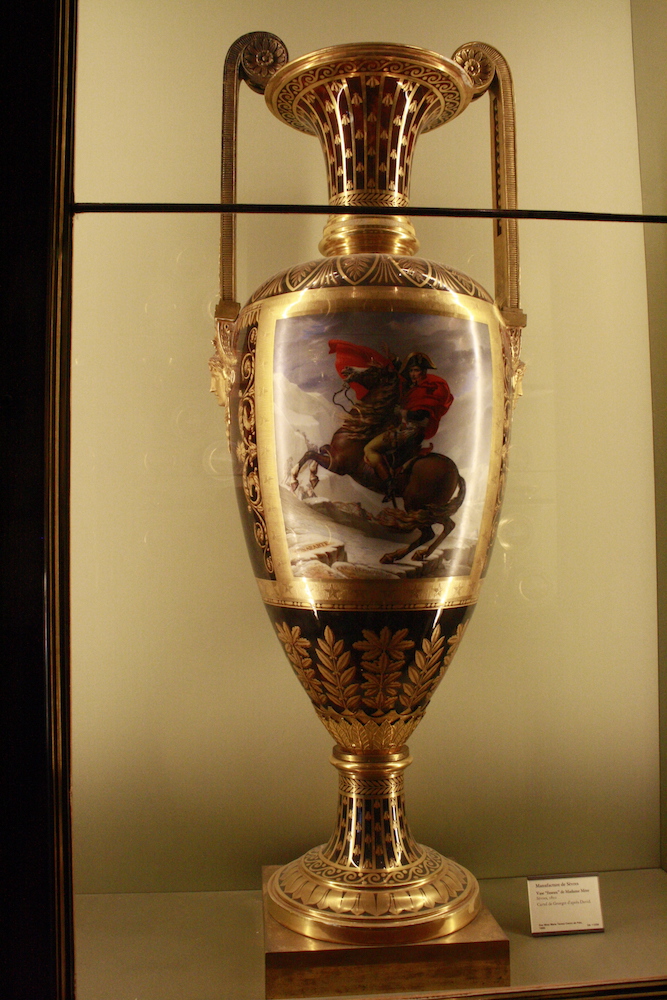

And somehow we ended up completely above the Louvre Pyramid this time. I like this picture, though, because you can see people in the museum’s lobby through the glass.

Title: Gabrielle d’Estrées and One of Her Sisters, the Duchess of Villars
Artist: Unknown. (Thought to be the work of a painter from the Fontainebleau School in France.)
Date: circa 1594
Info: Oil on wood. “The models have been identified as Gabrielle d’Estrées (1571-99), the favorite of Henry IV (1553-1610), and one of her sisters: the Duchess de Villars or Madame de Balagny. The oddly affectionate way in which the sister is pinching Gabrielle d’Estrées’ right breast has often been taken as symbolizing the latter’s pregnancy with the illegitimate child of Henry IV. This interpretation would seem to be confirmed by the scene of the young woman sewing – perhaps preparing a layette for the coming child – in the background.
Although very much in the style of the second school of Fontainebleau, this work remains anonymous. It shows the influence of Italian Renaissance art in the sensual contours of the bodies of the two young women, but also contains references to Flemish art, such as the intimacy of the background scene.”

And I think that does it for our trip to the Louvre Museum. We thoroughly enjoyed our trip, and as I said at the beginning of all of this, we could have easily walked around for several more hours.
I’m very thankful that the Louvre’s website has “highlighted” pieces. It selects several of the more popular pieces throughout the museum and gives information (title, date, artist, etc) in English. The placards associated with each piece inside the museum were all in French, which doesn’t always translate well in the world of art.
So, is that it for the day? Absolutely not. What could top the Louvre? Well, Brittany and I were celebrating our 1-year anniversary so we had to rush home and get ready for our anniversary date (mysteriously arranged by Brittany).
We had our anniversary date on top of the Quai Branly Museum at a restaurant called Les Ombres (Shadows), and while their food was quite delectable that wasn’t what they were known for.
Instead they are known as being in “the shadow” of the Eiffel Tower.
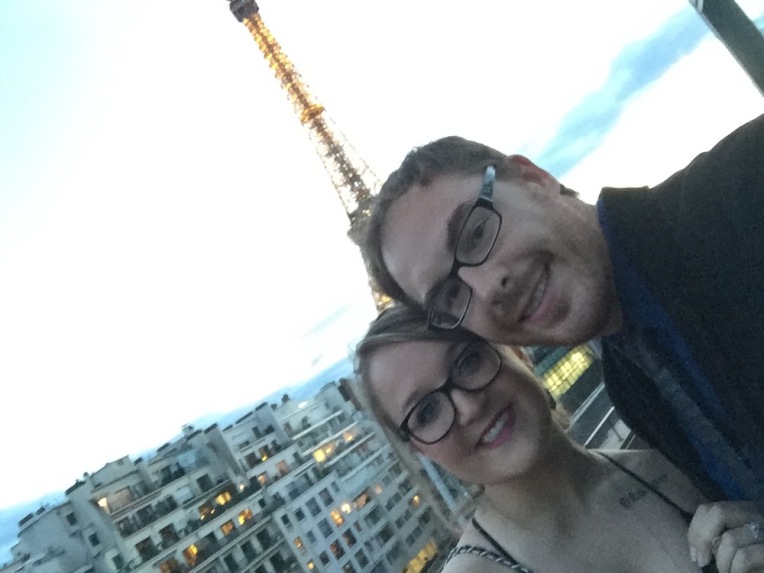
Truly one of the best places to view the Eiffel Tower…
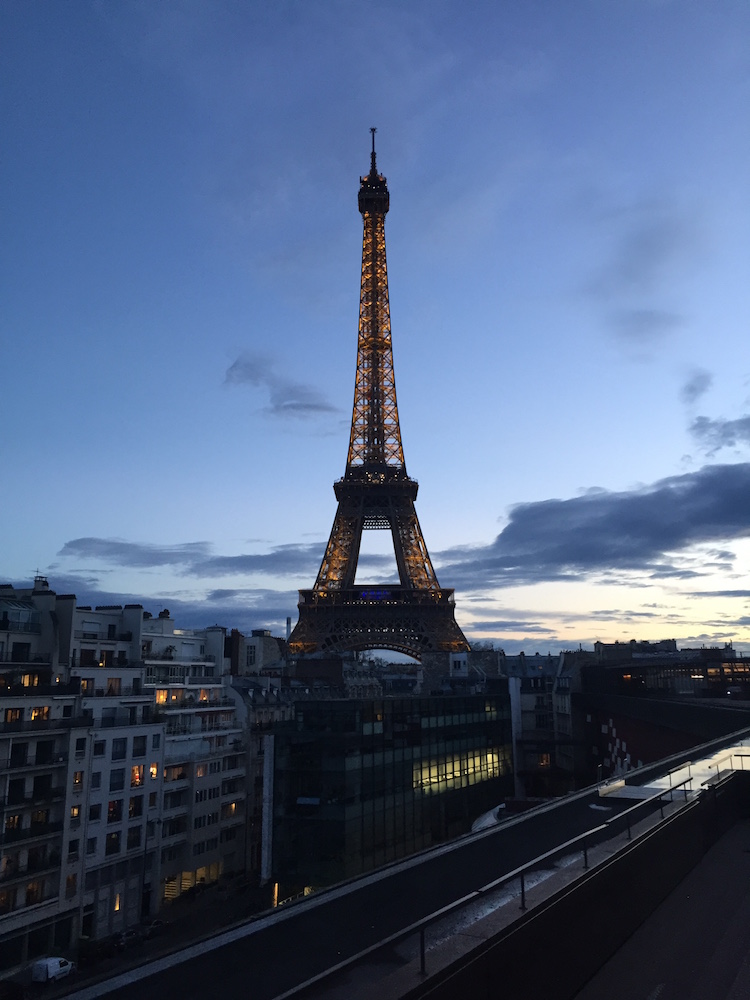
The restaurant offered us a spectacular view of the tower while we ate…

It wasn’t quite warm enough for them to have the outdoor roof terrace open, but we could walk around on it as much as we wanted.

After dinner (and dessert of course) we walked around the roof for quite a while.

And we ended up getting some really amazing shots of the tower reflected off of the water pooled on the museum’s rooftop.


And let me just take one more opportunity to tell my muse just how much I enjoyed our anniversary date…just how much I enjoy all of our life together.
We left the restaurant, but it was almost time for the tower to twinkle again, so we took a short stroll over to watch from the base.

The Eiffel Tower really is something to behold…especially at night…


At this point, a few street vendors tried to sell us bottles of beer and champagne…which we hadn’t seen up to that point.
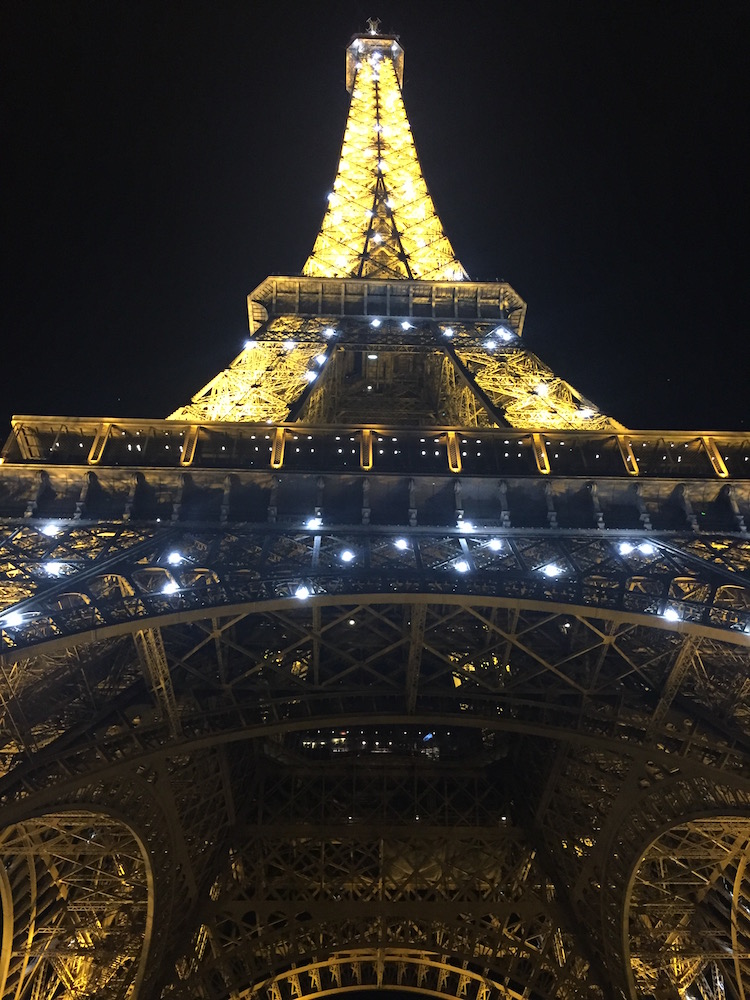
So beautiful to watch…

Well, that was that. I don’t think we could have asked for a better anniversary!
However, the end of Monday night held a choice for us. We had already purchased tickets to go to the symphony on Tuesday night, and we had already purchased tickets to go to Disneyland Paris that were good for any weekday (which meant either Tuesday or Wednesday for us). The problem…tickets to Disney were WAY more expensive than tickets to the symphony, and the Weather Channel app had been calling for a 90% chance of severe thunderstorms on Wednesday. We both really wanted to go to the Symphony, but would it be worth sacrificing what we paid for admission to Disney to go and have everything be rained out? Dilemma. So what did we do…Symphony or Disney? Find out on Day 6.


